
Empowering SMEs for a Greener Future: Business Plan Training Under the PLASTICS Project


Small and medium enterprises (SMEs) play a critical role in Sri Lanka’s transition to a circular economy. Recognising this, the EU-funded PLASTICS Project has been equipping 152 SMEs in the plastic recycling value chain with vital business skills to drive sustainability and profitability.
In collaboration with the Industrial Services Bureau (ISB), the project has successfully conducted seven intensive 5-day Business Plan Preparation Training programmes in Sri Lanka’s Western Province. These sessions, held in Gampaha, Colombo, and Kalutara districts, have already resulted in the creation of 113 detailed business plans, with eight more in progress. An additional training session is scheduled for December 2024, targeting another 15-20 SMEs.
Building a Foundation for Success
The training sessions go beyond the basics of business planning, focusing on integrating principles of sustainability and innovation into long-term strategies. The business plans incorporate:
- Vision, Mission, and Objectives to guide organisational growth.
- Marketing, Production, and Human Resource Plans to streamline operations.
- Financial Projections and Ratio Analysis for informed decision-making.
Participants were trained to include critical elements such as resource efficiency, cleaner production, green investments, and social and gender inclusion—aligning their businesses with the circular economy.
Turning Plans into Progress
The impact of these training programmes has been transformative for many SMEs:
- Structural Improvements: Participants gained practical knowledge to refine operations and enhance productivity.
- Better Financial Insights: SMEs now understand profit and loss analysis, enabling smarter investments.
- Access to Funding: Several businesses have already secured bank loans and grants by presenting their professionally crafted business plans.
These plans also provide a gateway for SMEs to access other opportunities offered by the PLASTICS Project, including:
- Green financing and RECP (Resource Efficiency and Cleaner Production) assessments.
- QEMS (Quick Environmental Management System) certification and ISO 14001 compliance.
- Participation in buyer-seller forums, fostering valuable market connections.
A Collaborative Effort
The success of these training sessions is a testament to the collaborative approach of ISB, ACTED, and the PLASTICS Project. Experienced trainers and business development experts led the sessions, supported by ACTED staff who ensured smooth logistics and organisation.
A Path Towards Sustainability
This initiative has become a turning point for many SMEs, empowering them to adopt sustainable practices, improve operations, and thrive in a competitive market. By integrating circular economy principles into their strategies, these businesses are not only reducing environmental impact but also strengthening their resilience and profitability. The PLASTICS Project remains committed to fostering sustainable SME development, one business plan at a time.


Interactive Wetland Experience for the Next Generation
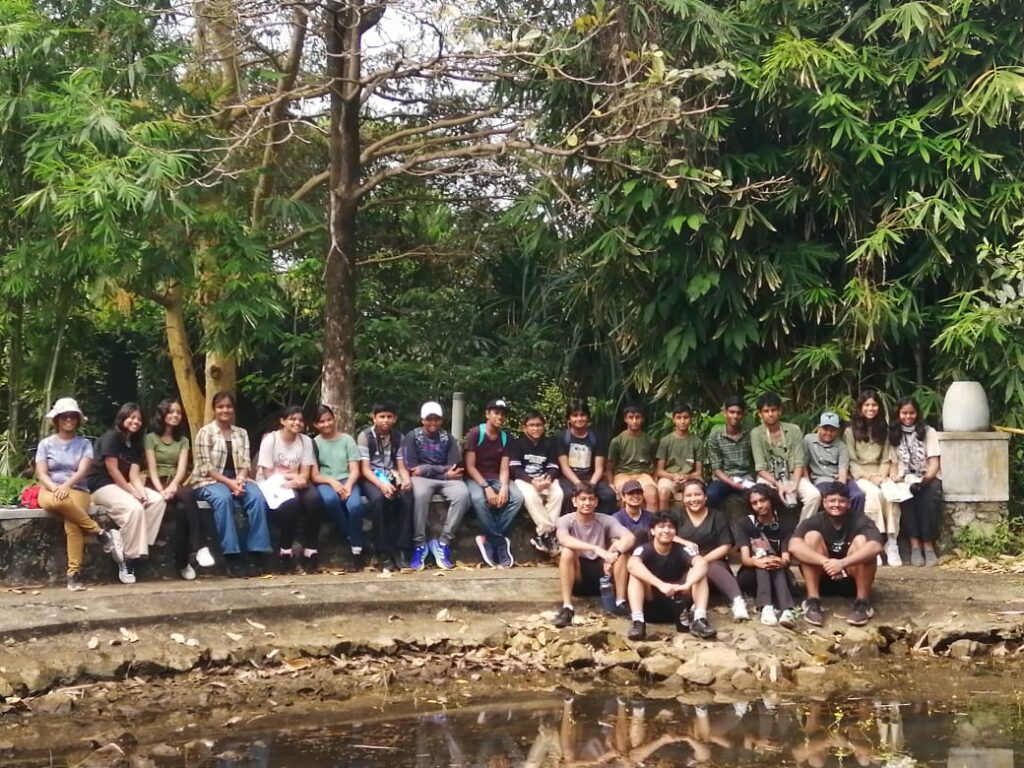
In collaboration with Dole Lanka and Cargills Ceylon PLC, BSL organized an educational Wetland Walk at Diyasaru Park for students of Stafford International School on 5th February 2025. The walk provided young minds with the opportunity to explore the biodiversity of wetlands, observe their ecological significance, and understand their role in climate resilience and water purification. This immersive experience allowed students to observe firsthand the rich biodiversity of wetlands and understand their critical functions, such as acting as natural water purifiers and buffers against climate impacts.
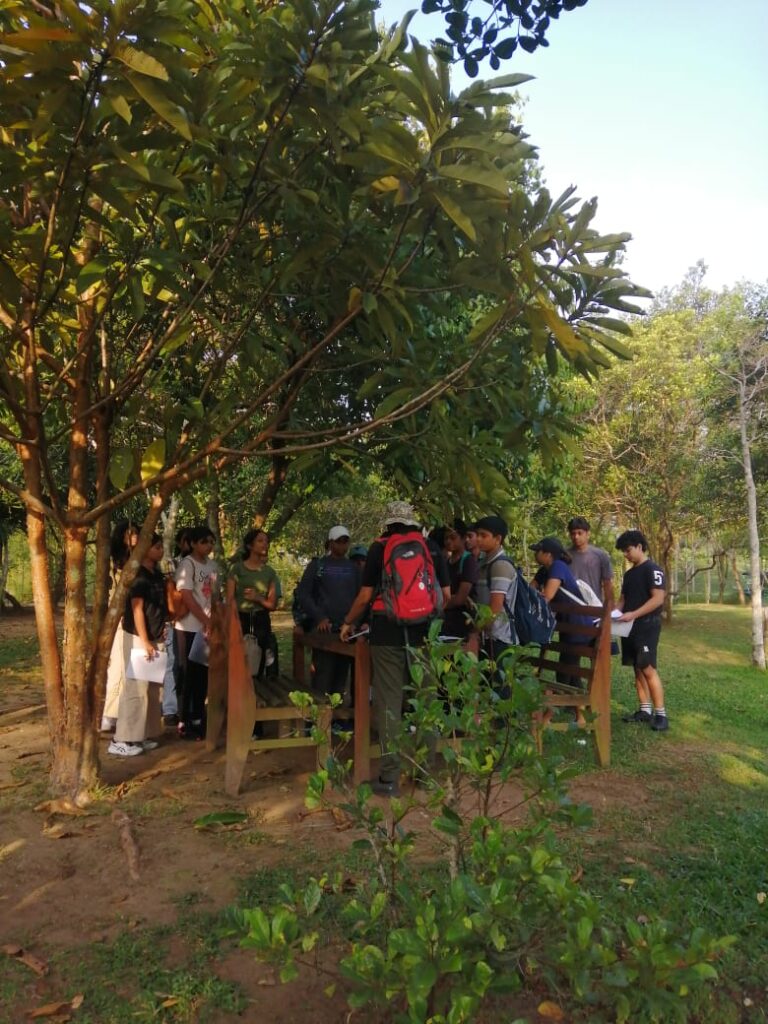
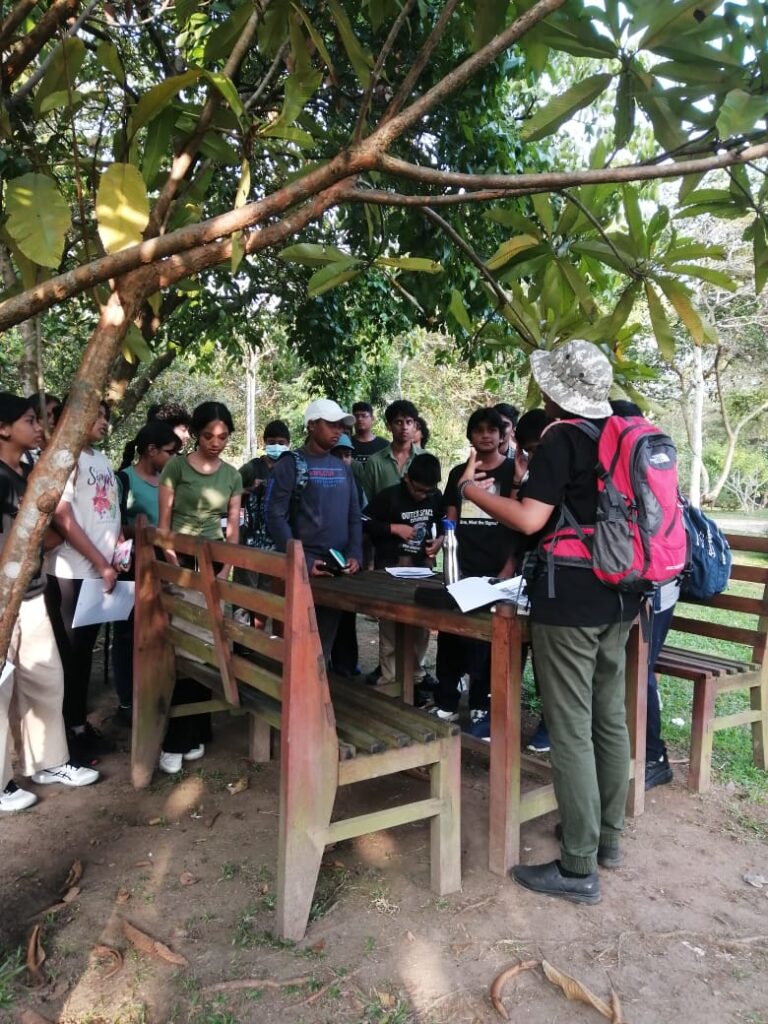


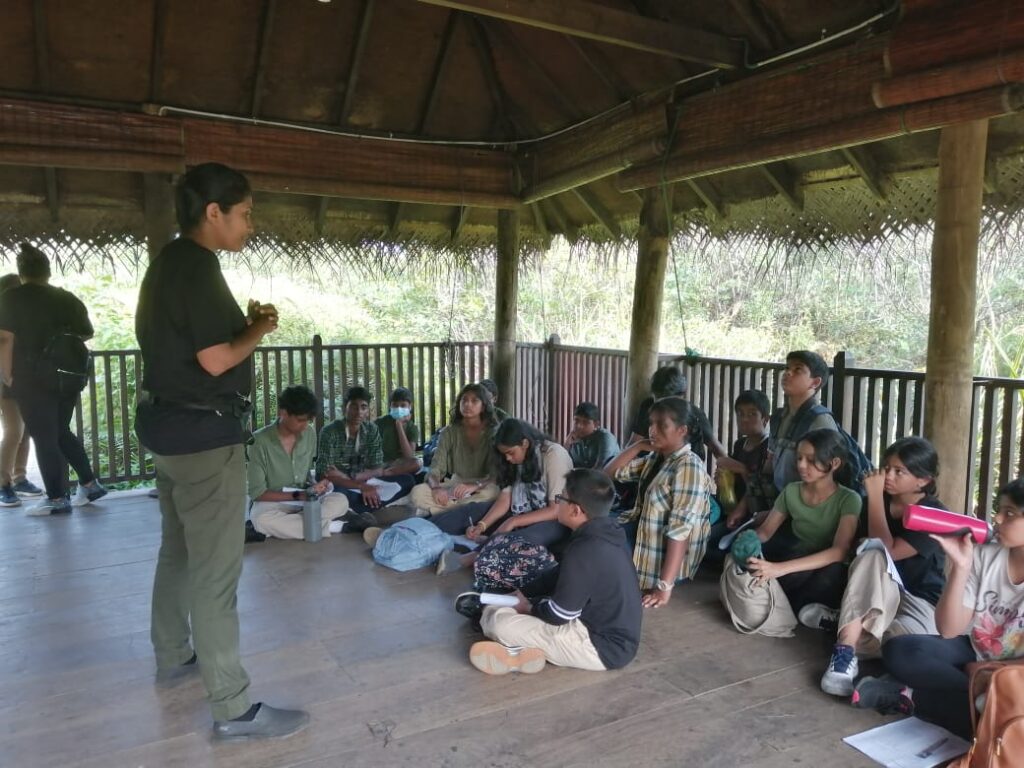
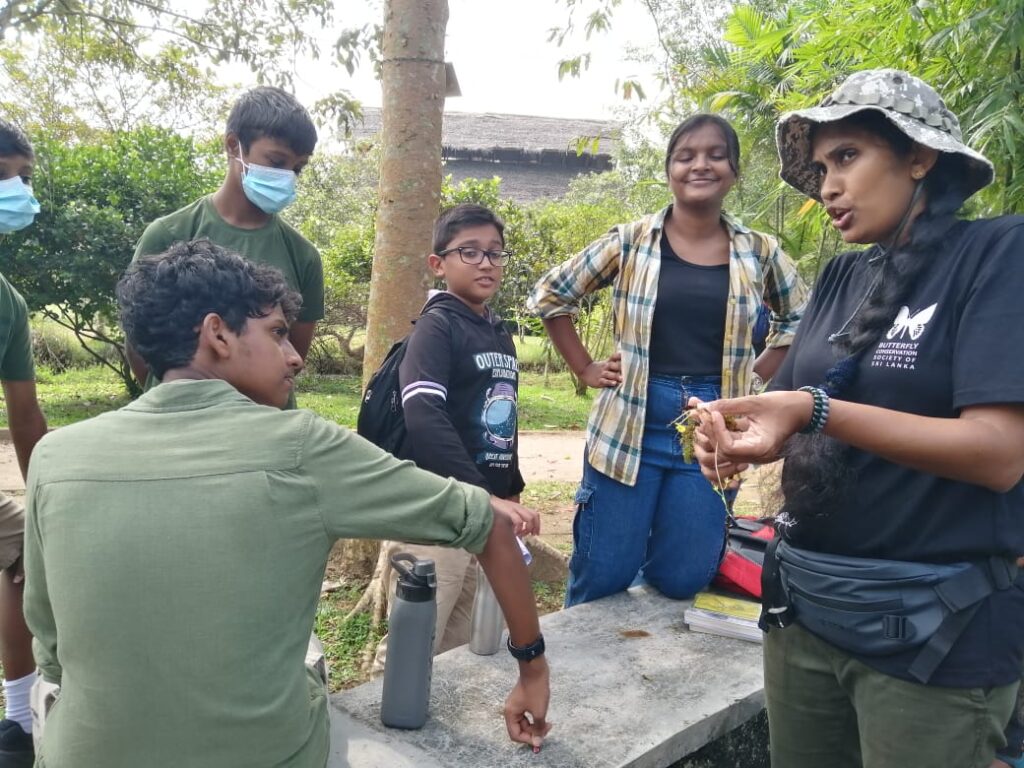
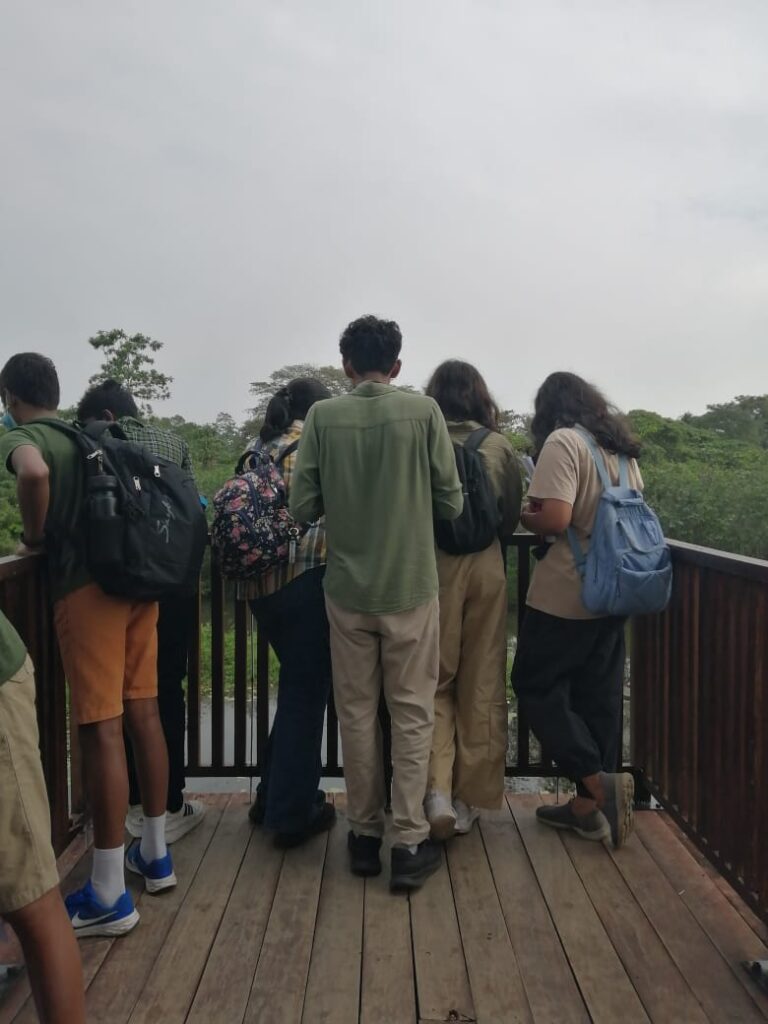
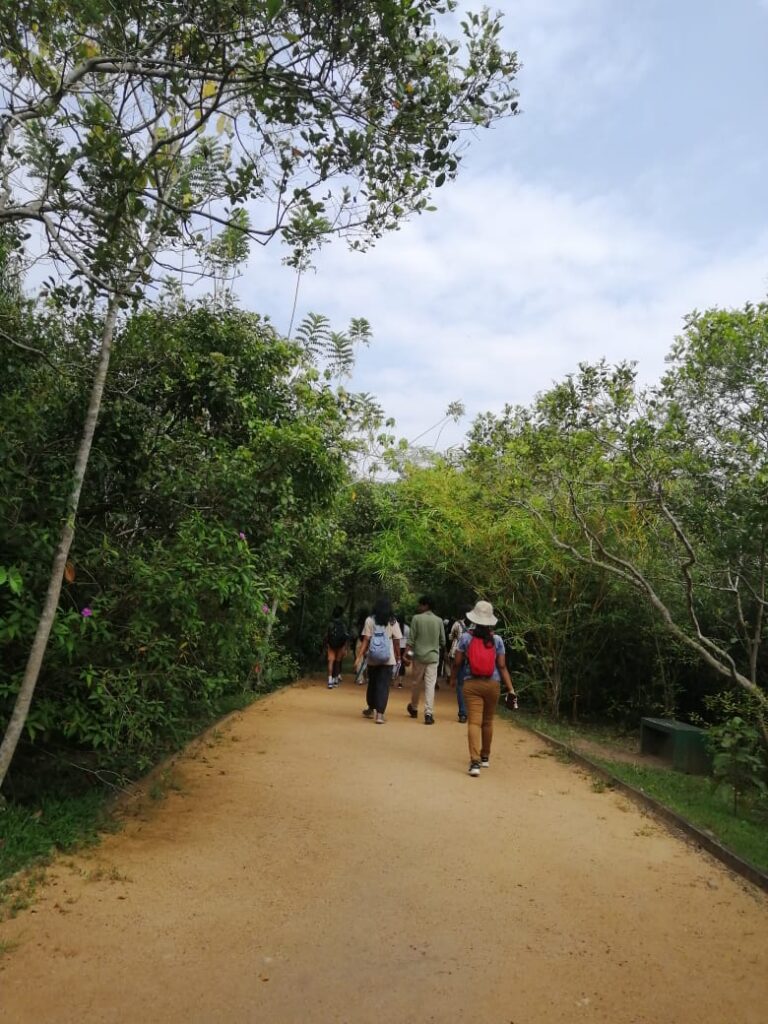
The students were introduced to the concept of wetlands as ‘nature’s kidneys’, filtering pollutants and supporting a diverse range of species. Through interactive discussions, they learned about the threats wetlands face—including habitat destruction and pollution—and the importance of conservation efforts. The initiative underscored the critical role that youth play in safeguarding natural ecosystems for future generations. By engaging young minds, the initiative aimed to cultivate future stewards of environmental conservation.

Life to Our Beaches Fuels the Clean Sri Lanka Campaign
Sri Lanka’s picturesque coastline is under threat from marine pollution and mismanaged waste, challenges that not only harm the environment but also undermine the country’s tourism and economic potential. In response, the Life to Our Beaches Project is making a tangible impact, creating cleaner, more resilient coastal areas while offering significant opportunities for the private sector to contribute to a sustainable future.

Cleaning Up for a Clean Sri Lanka
The Clean Sri Lanka campaign is now setting the national agenda for environmental stewardship, and the Life to Our Beaches Project is a shining example of such a vision in action. Two pilot projects, located at Kalutara’s Calido Beach and Beruwala’s Kechchimale Beach Park, have demonstrated how targeted interventions can restore the natural beauty of our coastal areas. At Calido Beach, a 500-meter stretch that was heavily polluted by waste from the Kalu River, concerted cleanup efforts led by a partnership between the Ministry of Environment, Biodiversity Sri Lanka (BSL), and Commercial Bank have resulted in the removal of over 1,586 kilograms of waste. Similarly, the Kechchimale Beach Park project in Beruwala, supported by the Bank of Ceylon, tackled pollution stemming from plastic waste and sewage from the local fishery harbor, removing 169 kilograms of debris.
Beyond environmental cleanup, these initiatives have also provided socio-economic benefits. Beach caretakers, who are predominantly from economically disadvantaged communities, have earned supplementary income through the recycling of waste. For example, the caretaker at Calido Beach generated earnings of LKR 35,585 through recyclable sales. Such outcomes not only contribute to a cleaner environment but also enhance livelihoods, underscoring the holistic benefits of sustainable beach management.
Opportunities for the Private Sector
For private sector players, the Life to Our Beaches Project represents more than just a charitable endeavor—it is a strategic opportunity to drive corporate social responsibility (CSR) initiatives, boost brand reputation, and contribute to the national Clean Sri Lanka campaign. Companies that invest in or sponsor these projects can benefit from enhanced visibility, positive community engagement, and alignment with global sustainability trends.
Leading financial institutions like Commercial Bank and the Bank of Ceylon have already set a precedent by supporting these initiatives. Their involvement demonstrates how aligning business strategies with environmental goals not only fulfills regulatory and CSR mandates but also opens up new avenues for innovation and growth. In today’s market, consumers and investors increasingly favor companies that are committed to environmental stewardship, and involvement in such projects can significantly enhance corporate image and competitiveness.



Scaling Up and Future Prospects
Building on the success of the pilot projects, the Life to Our Beaches Project is set to expand to new locations, including Kayankerni Beach in Batticaloa, Eastern Province. This expansion aims to replicate the successes seen at Calido Beach and Kechchimale Beach Park while addressing unique challenges specific to each coastal region. The new project in Batticaloa will focus on reducing plastic pollution, improving waste management systems, and empowering local communities through sustainable beach stewardship.
Moreover, future efforts will include continuous training for beach caretakers to enhance their operational efficiency, structured recruitment and retention strategies to maintain long-term commitment, and the launch of media campaigns to boost public awareness and attract further corporate support. By scaling up these initiatives, the programme aims to create a network of clean and sustainable beaches across Sri Lanka, contributing significantly to the Clean Sri Lanka campaign and setting a benchmark for environmental responsibility in the private sector.
A Call to Action for Sustainable Impact
The transformation of Sri Lanka’s coastlines through the Life to Our Beaches Project exemplifies how coordinated efforts between government, NGOs, and the private sector can lead to measurable environmental and socio-economic improvements. For the private sector, this initiative offers a unique platform to drive innovation in waste management, foster sustainable business practices, and demonstrate a commitment to the nation’s environmental goals.
As Sri Lanka strives towards a cleaner, more sustainable future, the active participation of private companies is crucial. By investing in these projects, businesses can not only help protect one of the country’s most valuable natural assets but also contribute to the broader national agenda of a Clean Sri Lanka. In doing so, they will not only reap economic and reputational benefits but also play a pivotal role in shaping a greener, more resilient future for all.
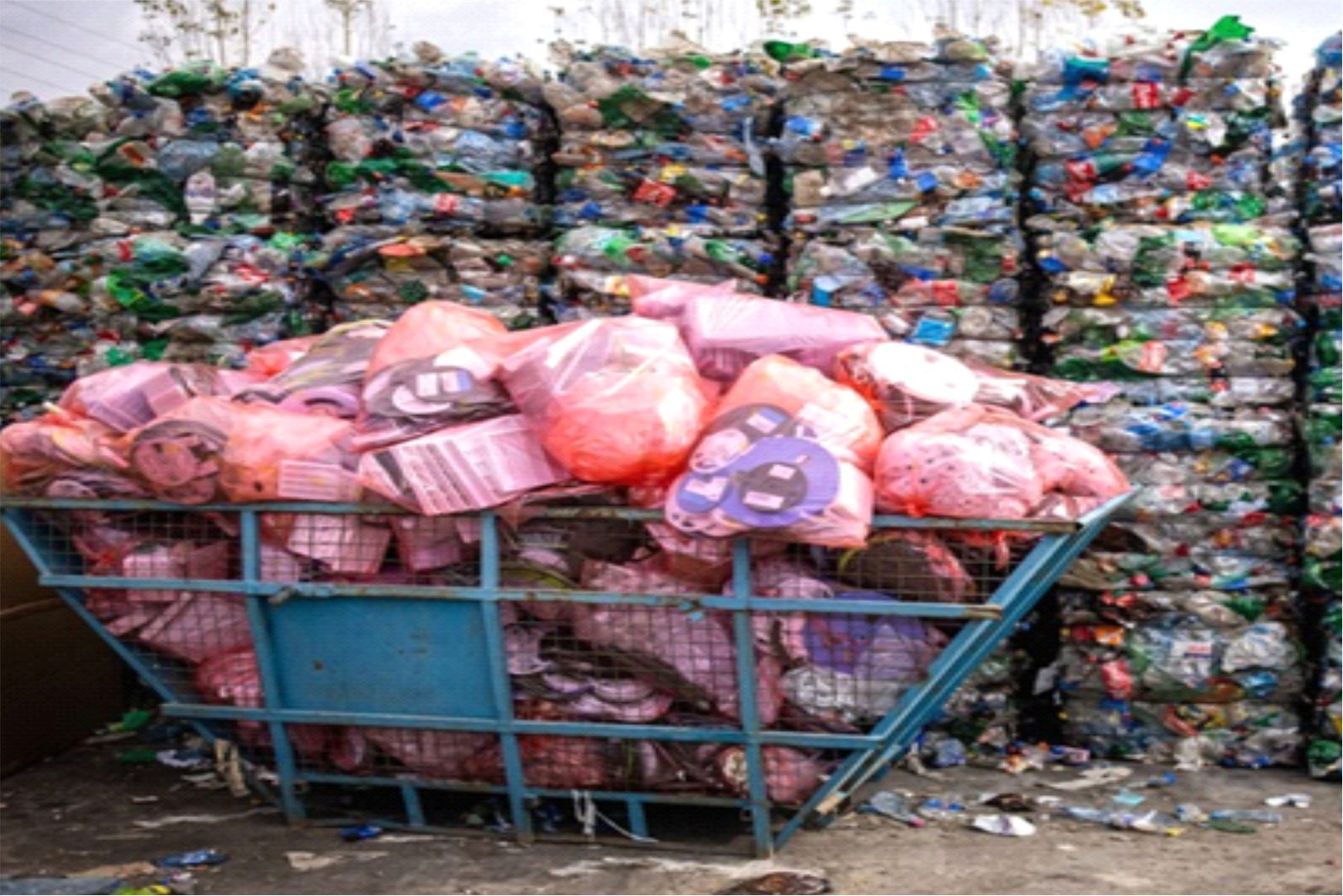
The PLASTICS Project and Sri Lanka’s Sustainable Future

Biodiversity Sri Lanka (BSL), in partnership with ACTED, the Industrial Services Bureau (ISB), STENUM Asia, and The Energy and Resources Institute (TERI) of India, is spearheading the Promoting Long-term Approaches for a Sustainable, Transformative, and Inclusive Circular Economy in Sri Lanka (PLASTICS) project. This 48-month initiative, funded by the European Union’s SWITCH-Asia program, is revolutionising the plastics value chain by integrating Small and Medium Enterprises (SMEs) into sustainable business practices that foster economic prosperity while tackling environmental challenges.
Rethinking Plastics: A National Priority
Sri Lanka imports over 500,000 metric tons of virgin plastic annually, contributing to nearly 1.59 million metric tons of mismanaged plastic waste each year. Recognising the urgency of addressing this crisis, the PLASTICS project focuses on transforming the plastic lifecycle across Sri Lanka’s Western Province. By targeting 150 SMEs engaged in plastic production, use, and recycling, the project enhances resource efficiency, promotes circular innovations, facilitates access to green finance, and strengthens waste management frameworks.
The project aligns closely with the Sri Lankan Government’s National Action Plan on Plastic Waste Management 2021–2030, which emphasszes the need to transition from a linear economy to a circular one. This shift is built on the principles of reducing, reusing, and recycling plastics while implementing Extended Producer Responsibility (EPR) schemes. As part of this effort, BSL is leading the expansion of the national plastics EPR Portal, which will play a crucial role in ensuring producer accountability and improving waste traceability through digital monitoring systems.



Milestones Achieved So Far
The PLASTICS Project Consortium has made significant progress in building momentum for a circular plastics economy. A key focus has been engaging a diverse group of stakeholders, including SMEs, entrepreneurs, policymakers, and financial institutions. Through workshops and training sessions, businesses have gained insights into sustainable practices, circular product design, and ways to integrate eco-friendly alternatives into their operations.
The project has also actively supported SMEs with critical asset provisions to strengthen their operational capabilities. Equipment such as baler machines for PET bottle compression, shredder machines for plastic flake production, and crusher machines for reducing plastic into fine granules have been distributed. This investment ensures that SMEs can process and manage plastic waste more effectively, fostering a sustainable business ecosystem.
Recognising the financial barriers that often hinder SMEs from adopting green practices, the project has introduced initiatives to improve access to green financing. A Digital Green Finance Toolkit has been developed to bridge knowledge gaps and empower financial institutions to support eco-friendly business models. Practitioner forums and collaborative platforms are building confidence among investors and businesses in financing sustainable plastic waste management solutions.
Public-private collaboration has been a cornerstone of the consortium’s approach. By fostering dialogue between industries, policymakers, and regulatory bodies, the PLASTICS Project Consortium has helped develop robust monitoring frameworks that support transparent and effective plastic waste management across industries. The innovative 3Zero House initiative, launched in Colombo, Vavuniya, and Batticaloa, serves as an incubator for entrepreneurs and businesses committed to sustainability. Through a dedicated incubation program, eight pioneering businesses – such as ALKE, Ample, Solocycle, and Teshvo – are developing scalable solutions in areas like alternative packaging, sustainable fashion, and eco-friendly building materials.
Why the Private Sector Should Get Involved
The PLASTICS project is creating new business opportunities while addressing environmental challenges. Companies that adopt circular economy principles gain access to innovation and increased competitiveness in both local and international markets. Businesses integrating sustainable product design and packaging will be better positioned to comply with upcoming regulations and attract environmentally conscious consumers.
Furthermore, the expansion of green finance accessibility presents an opportunity for companies to invest in sustainable technologies and business models. Financial incentives and tailored funding solutions are being introduced to help SMEs transition toward low-impact manufacturing processes, offering a major advantage for businesses looking to future-proof their operations against regulatory changes while reducing long-term costs through resource efficiency.
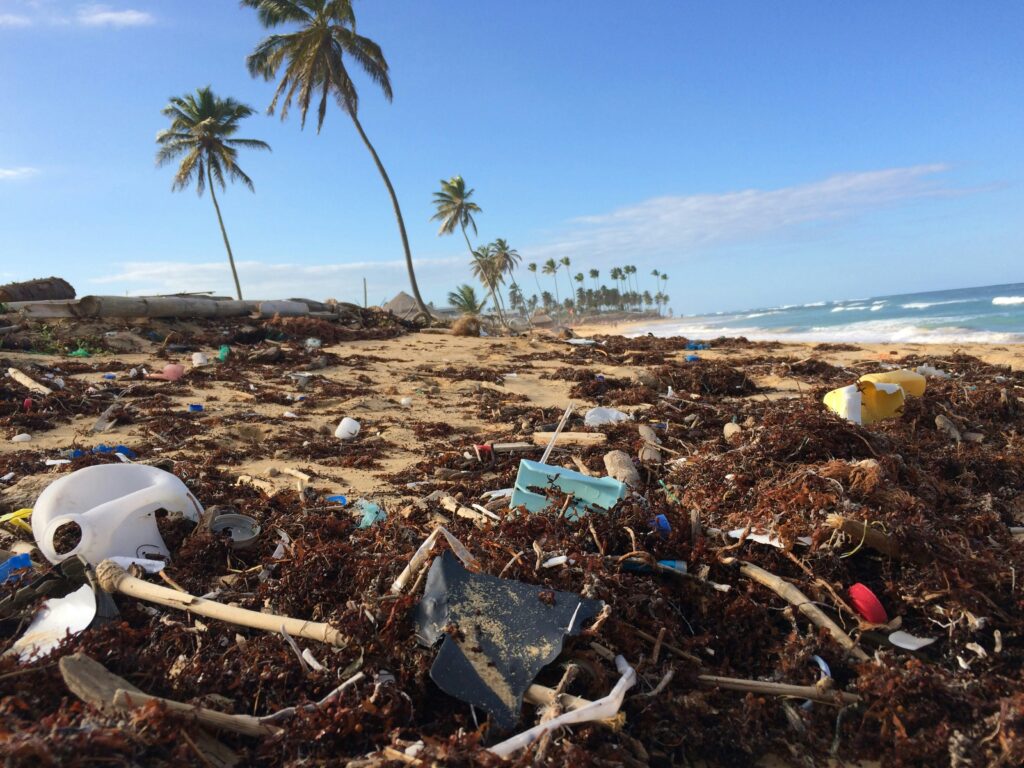
Scaling Up for the Future
Building on its success, the PLASTICS project is set to scale up circular innovations by supporting SMEs in adopting advanced technologies that minimize plastic waste and promote the use of sustainable materials. The consortium is actively working alongside the Central Bank of Sri Lanka and the EU Delegation to Sri Lanka and the Maldives to promote green finance frameworks that align with global sustainability goals. Recent strategic briefings on the delivery of green financial services have emphasized the importance of integrating environmental risk assessments into financial processes, reinforcing the consortium’s efforts in advancing circular economy solutions and influencing national financial policies.
As Sri Lanka deepens its commitment to a circular economy, policy frameworks must evolve to support long-term sustainability. The consortium will continue working closely with policymakers to advocate for stronger regulations that facilitate EPR schemes, incentivize sustainable product design, and promote responsible plastic use across industries. Community engagement and awareness campaigns will also be vital in educating consumers about the importance of reducing plastic consumption and supporting sustainable alternatives.
Shaping the Future of Plastics in Sri Lanka
The work of the PLASTICS Project Consortium stands as a testament to the power of BSL’s leadership in promoting collaborative innovation and driving corporate sustainability as well as environmental responsibility. By fostering innovation, strengthening policy frameworks, and equipping businesses with the tools to integrate circularity, the consortium—led by its esteemed partners—is setting the stage for a future where economic growth and environmental stewardship go hand in hand. This initiative not only addresses the pressing issue of plastic pollution but also creates new opportunities for sustainable development and positions the private sector as a leader in Sri Lanka’s green transformation.

Leading Wetland Restoration in Sri Lanka
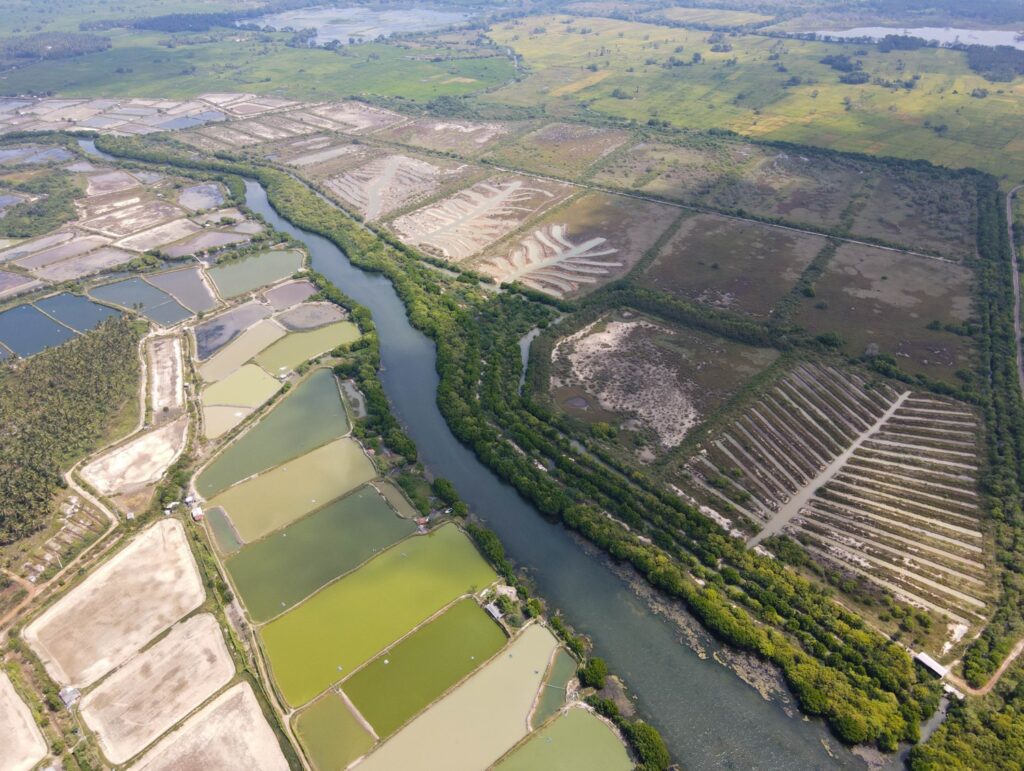
Biodiversity Sri Lanka (BSL) continues to lead the way in mangrove restoration with its Life to Our Mangroves (LOM) project, a collaborative effort aimed at revitalizing the Anavilundawa Ramsar wetland sanctuary. This vital ecosystem, located in Sri Lanka’s North Western Province, has faced significant degradation due to environmental changes, but through strategic partnerships and scientific restoration efforts, it is being restored to its natural state.
Scaling Up Restoration Efforts
With the support of 10 key partner organizations, including Dilmah, Sampath Bank, CDB, NDB, Dole, Dynawash, Easwaran Brothers, Virtusa, LOLC Finance, and Amana Bank, BSL is actively working on restoring 13.96 hectares of mangrove and associated ecosystems. Of this, 6.06 hectares are designated for true mangrove restoration, while 7.9 hectares are being developed with mangrove-associated and dry-zone vegetation to enhance habitat connectivity. Progress has been steady, with plot 7 demonstrating an 80% survival rate for 3,000 newly planted true mangroves. Approximately 3,000 Avicennia spp. seeds have been scattered to encourage natural regeneration, and 750 additional nursery plants have been introduced. Plots 20 and 21 now feature a fully operational plant house housing 1,000 dry-zone plants, with 300 already mature enough for field planting. Meanwhile, in plot 5, invasive species are being systematically removed, and canal dredging is scheduled for early 2025, ensuring optimal water flow before new plantings begin.

Integrating Carbon Finance and Climate Resilience
A major component of the LOM project is leveraging carbon offsetting as a sustainable funding mechanism. BSL has initiated a pre-feasibility carbon assessment in partnership with the Sri Lanka Climate Fund under the Ministry of Environment, which includes soil analyses and potential valuation of carbon sequestration efforts. Although government directives currently limit carbon finance crediting for extensive mangrove restoration, carbon offsetting remains a promising avenue that BSL is actively exploring.
To further ensure the long-term viability of the wetland and its surrounding communities, BSL is developing a climate adaptation plan. This initiative, carried out in collaboration with the Climate Change Secretariat, Global Green Growth Institute (GGGI), and the Centre for Poverty Analysis (CEPA), involves a socio-economic assessment to understand community interactions with the ecosystem. Additionally, BSL is working with the Green Movement (GMSL) to conduct a baseline study, providing essential data to tailor conservation efforts effectively.




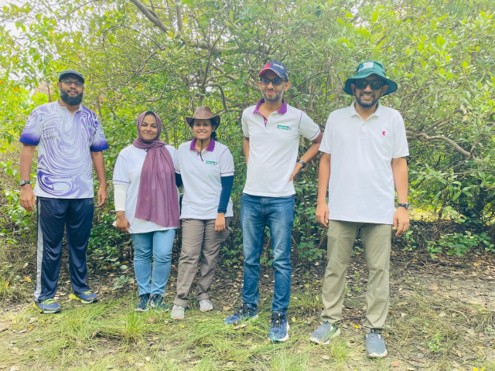

Strengthening National Conservation Strategies
BSL is playing a crucial role in aligning its restoration work with national environmental goals. One key focus is updating Sri Lanka’s mangrove mapping, which currently relies on outdated 1985 aerial imagery. This effort, supported by World Vision, will provide accurate, up-to-date data essential for future conservation planning. Additionally, BSL is actively contributing to the Anavilundawa Sanctuary Management Plan, ensuring that restoration efforts are integrated into broader conservation strategies.
Empowering Communities Through Ecotourism and Education
The Life to Our Mangroves project is not just about ecological restoration; it is also fostering sustainable livelihoods for local communities. BSL is exploring sustainable ecotourism opportunities within the restored wetland area, offering alternative income sources while raising awareness about the importance of mangrove ecosystems. Future plans include educational programs, guided tours, and community-led conservation initiatives to deepen public engagement with wetland conservation.

A Model for Private Sector-Led Conservation
The LOM project stands as a leading example of corporate-driven conservation, demonstrating how businesses and environmental organizations can work together to achieve impactful restoration. With ongoing advancements in carbon finance, climate adaptation, and ecological restoration, BSL and its partners are paving the way for a more resilient and sustainable future for Sri Lanka’s wetlands. Mangroves are a lifeline for biodiversity, coastal protection, and carbon sequestration. Through the continued dedication of its partners, BSL remains committed to ensuring that these critical ecosystems are preserved and restored for generations to come.
#LifeToOurMangroves #MangroveRestoration #BiodiversitySriLanka #SustainableSriLanka #CarbonOffsetting #ClimateResilience

World Wetland Day Celebrations 2025: A Unified Effort to Protect Vital Ecosystems
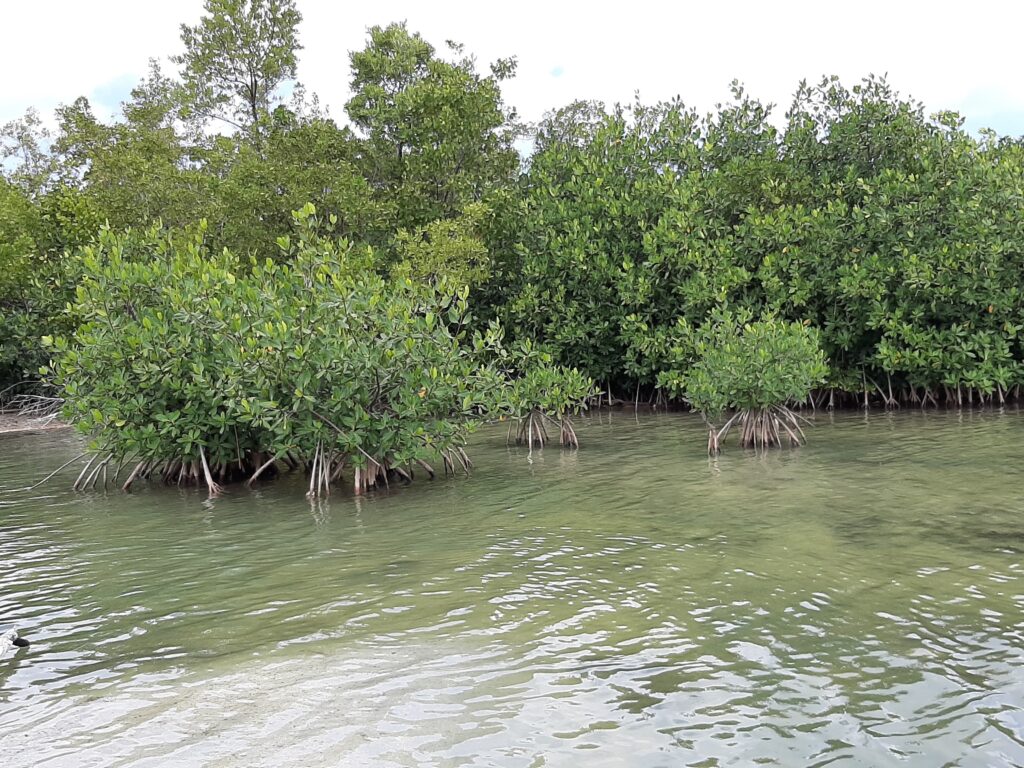
On 5th and 6th February 2025, Sri Lanka joined the global community in celebrating World Wetlands Day, under the theme “Protecting Wetlands for Our Common Future”. This theme is particularly pertinent to Sri Lanka, a nation endowed with diverse wetland ecosystems that are vital for ecological balance and community livelihoods. Wetlands in Sri Lanka serve as habitats for numerous endemic species, support agriculture and fisheries, and act as natural defenses against flooding and erosion. However, these ecosystems face threats from urbanization, pollution, and climate change. The theme calls for collective action to safeguard these invaluable resources, ensuring they continue to benefit both nature and society. In alignment with this global initiative, Biodiversity Sri Lanka (BSL), in partnership with Cinnamon Grand Colombo, Tokyo Cement Group, Dole Lanka, and Cargills Ceylon PLC, orchestrated a series of events aimed at raising awareness and fostering collaborative conservation efforts.
Engaging the private sector
At the Cinnamon Grand Colombo, BSL, in partnership with the Tokyo Cement Group, hosted a high-level panel discussion focusing on Green Finance for Wetland Conservation on 6th February 2025. The forum convened experts from finance, environmental science, and policy-making sectors to explore sustainable funding mechanisms for wetland preservation. Discussions highlighted the economic valuation of wetlands and the integration of green finance into national strategies, emphasizing the necessity of public-private partnerships in mobilizing resources for conservation.




Key speakers at the event:
Ms. Chaturangi Wickramaratne (Researcher – Freshwater Ecologist, IWMI) highlighted how wetlands contribute to both ecological and economic stability, emphasizing the need for green finance integration into national economic strategies.
An interesting panel discussion was held moderated by BSL’s Senior Technical Advisor Ms Shiranee Yasaratne. The panelists included:
- Environmental Economist Lucy Emerton, who discussed the economic valuation of wetlands as a means of strengthening conservation policies.
- Nishantha Edirisinghe (Conservator General of Forests), who elaborated on Sri Lanka’s policy framework for wetland and mangrove conservation, focusing on the role of carbon offsetting initiatives.
- Professor Sewwandi Jayakody (Wayamba University), who explained how wetlands contribute to biodiversity conservation and climate resilience.
- Dr. Lalith Weragoda (Sampath Bank), who emphasized the growing role of the private sector in financing sustainable wetland conservation projects.




A Call for Stronger Public-Private Collaboration
The discussions stressed the importance of aligning Sri Lanka’s conservation goals with nature-based solutions, carbon offset strategies, and sustainable finance models. A key takeaway was the need for enhanced collaboration between policymakers, financial institutions, and conservation experts to ensure the long-term protection of wetlands. The event concluded with a call to action for increased investment in wetland restoration, stronger policy support, and innovative financial mechanisms to bridge conservation efforts with economic sustainability.
Looking Ahead: A Commitment to Conservation
The events organized by BSL exemplify a holistic approach to wetland conservation, combining education, financial investment, and policy dialogue. By aligning local initiatives with the global theme, Sri Lanka demonstrates its commitment to preserving wetlands as a shared responsibility. As the world prepares for the 15th Meeting of the Conference of the Contracting Parties to the Convention on Wetlands (COP15) in July 2025, these efforts underscore the importance of unified action in protecting wetlands for our common future.
Through these initiatives, BSL reaffirmed its commitment to wetland conservation and underscored the indispensable role of the private sector, financial institutions, and youth engagement in driving meaningful environmental change. As Sri Lanka continues to face ecological challenges, such proactive efforts will be essential in securing the future of its wetland ecosystems.
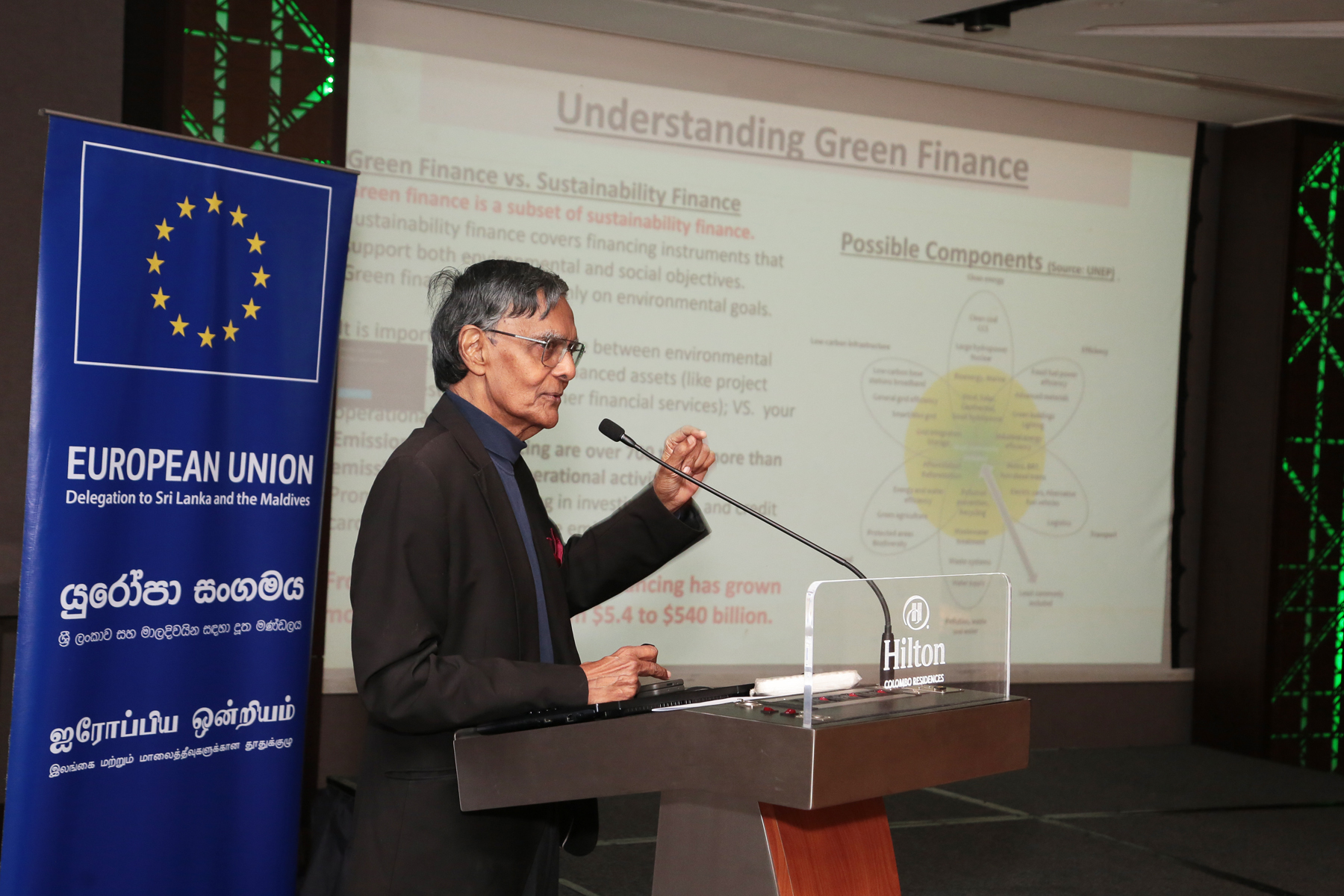
Sri Lanka’s Banking Sector: Embrace Green Finance or Fall Behind
Sri Lanka’s banking and financial sector is at a pivotal moment. With the global focus on sustainable investments, attracting green finance is now a necessity, not a choice. Professor Mohan Munasinghe, a renowned expert on sustainable development and climate finance, addressed Sri Lankan banking professionals at a seminar organised by Biodiversity Sri Lanka (BSL) under the Project PLASTICS initiative, funded by the European Union’s SWITCH-Asia programme. The event held on January 30 2025 at Jaic Hilton Colombo, aimed to help financial institutions promote a circular economy in Sri Lanka by providing them with necessary tools.
The seminar gathered 75 financial institution representatives to discuss the importance of green finance in promoting sustainable economic practices. The worldwide green finance market is growing quickly, with trillions of dollars going into projects focused on climate resilience, low-carbon, and biodiversity. For Sri Lanka’s banks to attract these funds, they must move beyond traditional lending models and embrace sustainability-aligned investment strategies.
Prof. Munasinghe’s Call to Action
Prof. Mohan Munasinghe, a Nobel Laureate and former Vice-Chair of the Intergovernmental Panel on Climate Change (IPCC), emphasised the golden opportunity for Sri Lanka’s financial institutions to adopt innovative sustainability-focused financial practices. He emphasised the need to follow global green finance standards and incorporate Environmental, Social and Governance (ESG) principles into policies to build investor confidence and stay competitive. Following frameworks such as the TCFD and TNFD can assist Sri Lankan banks in handling climate risks and appealing to global investors.
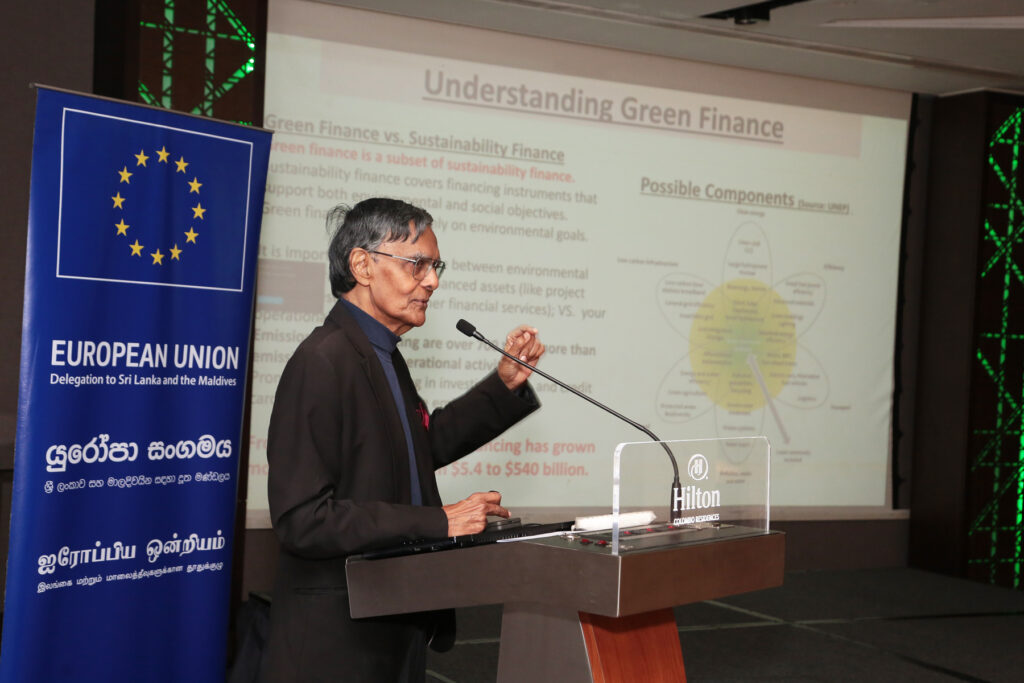

Driving Circular Innovation
Dr. Randika Jayasinghe emphasised the importance of banks in promoting the shift to a circular economy in Sri Lanka. She highlighted the need to shift from a linear to a circular economy to address climate change, biodiversity loss, and pollution. Banks can significantly influence the speed and scale of circular adoption through their investment decisions. Dr. Jayasinghe highlighted the importance of incorporating circular practices into financial strategies for sustainable financing and economic growth.
The Future of Business Sustainability
Sri Lanka is at a critical point in its economic and environmental path. As global industries adopt sustainability, the island nation needs to incorporate circular economy principles for long-term resilience. BSL’s Green Finance Specialist, Mr. Errol Abeyratne stressed the immediate importance of Sri Lanka shifting from a linear economic model to a circular one. He showed how industries can cut their carbon footprint and boost efficiency with circular business models that comply with global standards to stay competitive.


Resource Efficiency and Cleaner Production
Dr. Rajat Batra from STENUM Asia emphasised the negative effects of the linear economy on the environment and businesses, stressing the importance of transitioning to a Circular Economy and adopting Resource Efficient and Cleaner Production practices. He pointed out how wasteful resource flows in the linear economy led to environmental harm and increased business costs. Dr. Batra discussed effective methods from Europe and Asia, highlighting how industrial symbiosis and resource efficiency can lead to cost savings and environmental benefits.
The point of view of a business owner
Speaking on behalf of Small and Medium Enterprises (SMEs), Ample Clothing’s Co-Founder and Director Upekha Premathilaka highlighted the company’s commitment to sustainability and the circular economy, focusing on transforming plastic waste into biodegradable fabrics and promoting zero-waste fashion. She underscored the significant environmental impact of the fashion industry and the urgent need for sustainable practices. According to her, “Banks must evolve to support the circular economy, providing the necessary financial tools and investments to help businesses transition to sustainable models. Without this support, we risk being left behind in a rapidly changing economic landscape.”

Panel calls for a Green Financial Revolution
In closing, a highly interactive panel discussion was held with the participation of: Chief Manager SME Banking of Commercial Bank Mr Mohan Fernando; Head of Sustainability Union Bank Mr Adheesha Perera; Managing Director of Alliance Finance Mr Romani de Silva; and Group Chief Financial Officer of Aberdeen Holding Group Mr Anushka de Silva. The panel emphasised the significance of creating environmentally friendly financial products like green bonds, sustainability-linked loans, and low-carbon investment funds. These financial instruments provide a competitive edge and unlock new funding opportunities for climate-friendly businesses and projects in Sri Lanka. Supporting nature-based solutions (NbS) such as mangrove restoration and regenerative agriculture is essential due to their financial and environmental benefits.






The panel also cautioned that delaying action may cause Sri Lanka to lose billions in global climate finance. As developed nations and financial institutions focus on green investments, countries with policy misalignment risk missing out on international funding. The need to take action is emphasised by changing global regulations, like the European Union’s Carbon Border Adjustment Mechanism (CBAM).
For Sri Lanka’s financial sector to fully benefit from green finance opportunities, it must adopt a systematic and integrated approach. Strengthening collaboration between banks, government agencies, and conservation organisations is key. Financial institutions need to collaborate with policymakers to create policies that promote sustainable investments and adhere to global environmental standards.



Building Partnerships and Expertise
Establishing partnerships with global financial institutions is crucial. Several global banks and development finance institutions are looking for sustainable investment opportunities in emerging markets. Sri Lankan banks can attract long-term partnerships for economic resilience and environmental sustainability by taking proactive steps in green finance.
Building internal capacity and expertise is also essential. Financial institutions must invest in training programmes and knowledge-sharing initiatives to equip their teams with the necessary skills to assess and manage climate-related financial risks. Developing in-house expertise on green finance will allow banks to effectively structure sustainability-linked products and services while advising clients on transitioning to greener business models.



The Future of Banking
The global green finance movement is not a passing trend—it is the future of banking. Prof. Munasinghe’s insights provide a clear roadmap for Sri Lanka’s financial institutions to secure their place in this evolving landscape. With bold leadership, strategic action, and a commitment to sustainability, Sri Lanka’s banking sector can attract global green finance and position itself as a leader in Asia’s sustainable finance ecosystem. The time to act is now.


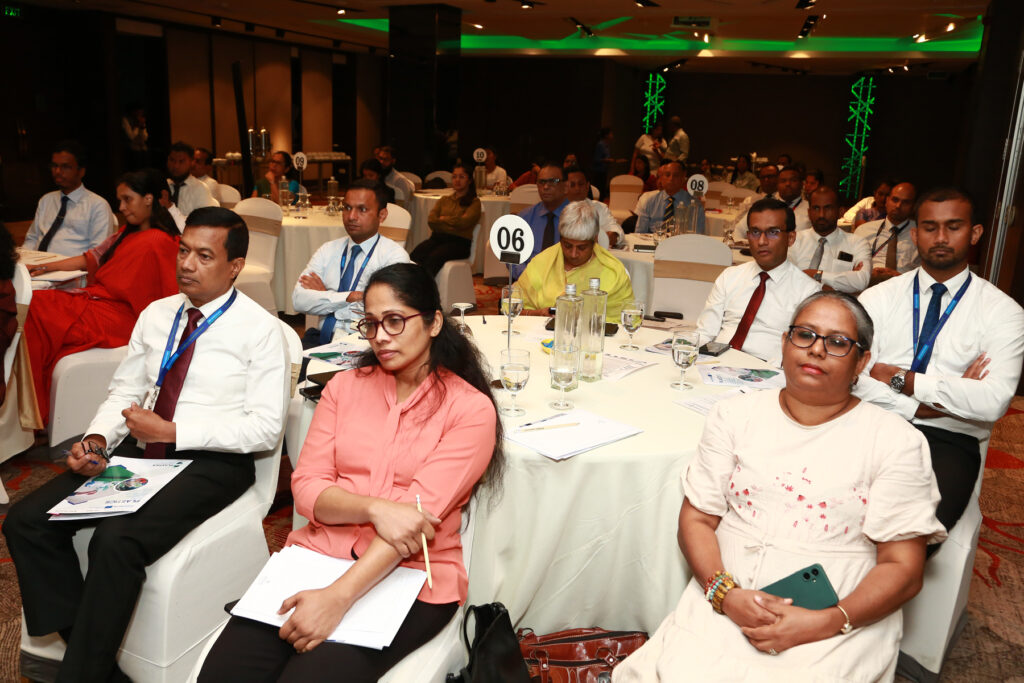
Sri Lanka can leverage frameworks like the European Union’s Circular Economy Action Plan (CEAP) and the UN’s Sustainable Development Goals (SDGs) to attract green investments and enhance global trade partnerships. However, challenges such as the lack of awareness and infrastructure to support circular economy initiatives must be addressed. Government-backed incentives and a clear regulatory framework are essential for a successful transition. To make Sri Lanka a regional sustainability leader, businesses need to use green finance, focus on sustainable sourcing, and build partnerships for circular economy principles. Policymakers should back these initiatives by enforcing sustainability regulations, providing incentives for green innovation, and promoting partnerships with international organisations.
By adopting these strategies, Sri Lanka’s banking sector can ensure its future in the global green finance landscape and support a sustainable and resilient economy.



Safeguarding Our Coral Reefs

The Kayankerni Reef, located in Sri Lanka’s Batticaloa District, is a marine sanctuary spanning 953 hectares, home to over 200 species of stony corals and 900 species of reef-associated fish. Its rich biodiversity supports the livelihoods of local fishing communities and boosts tourism in the region. Despite its ecological significance, the reef faces multiple threats, including overfishing, destructive fishing practices, unregulated tourism, and coral bleaching. The Life to Our Coral Reefs project, implemented under the Department of Wildlife Conservation and guided by IUCN’s Global Standard for Nature-based Solutions (NbS), seeks to restore reef health while enhancing sustainable livelihoods for the local communities.
A Two-Day Immersive Experience
On 5th and 6th December 2024, Biodiversity Sri Lanka (BSL) led a field visit to the Kayankerni Seascape, bringing together representatives from nine BSL member companies to witness firsthand the conservation efforts under the Life to Our Coral Reefs project. This initiative, designed to restore coral ecosystems and strengthen community resilience, aims to engage the private sector in marine conservation while promoting sustainable economic opportunities for coastal communities.
With four companies already committed as project partners, this visit played a pivotal role in fostering corporate engagement, deepening understanding, and identifying further collaboration opportunities.
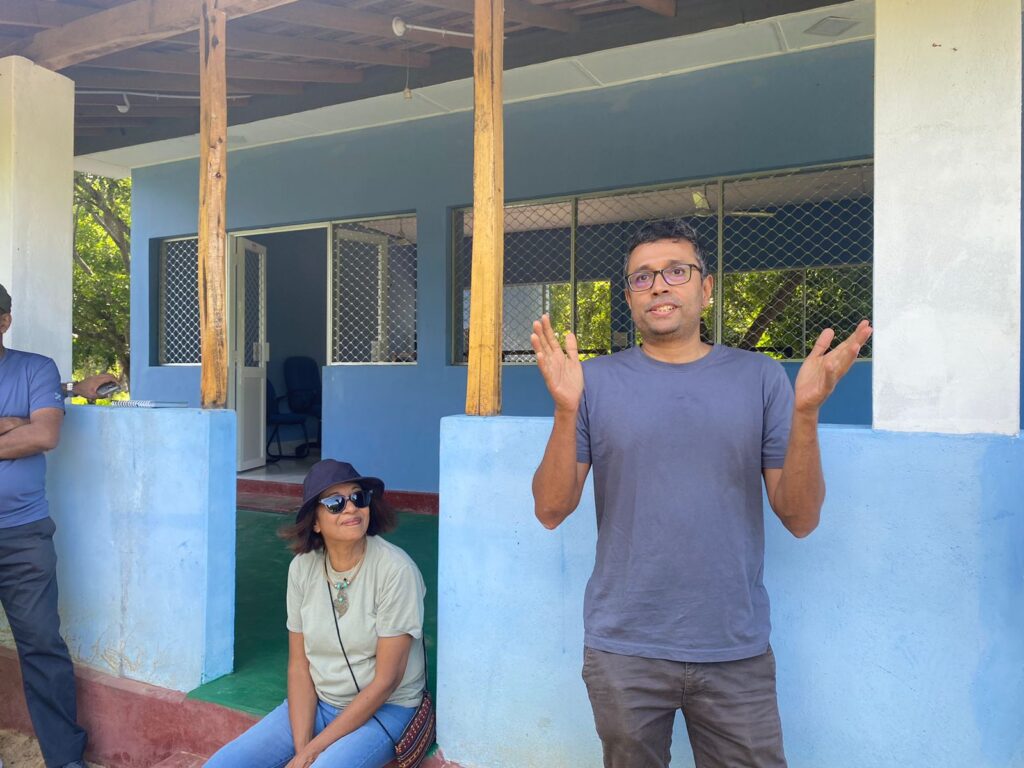
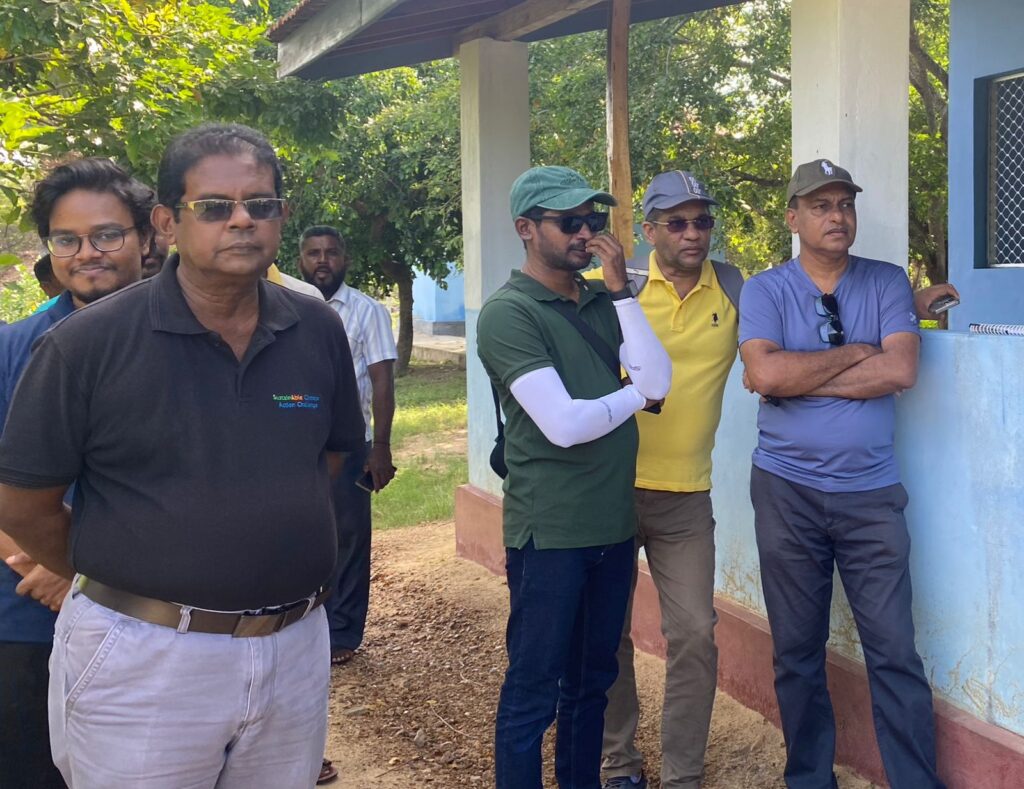
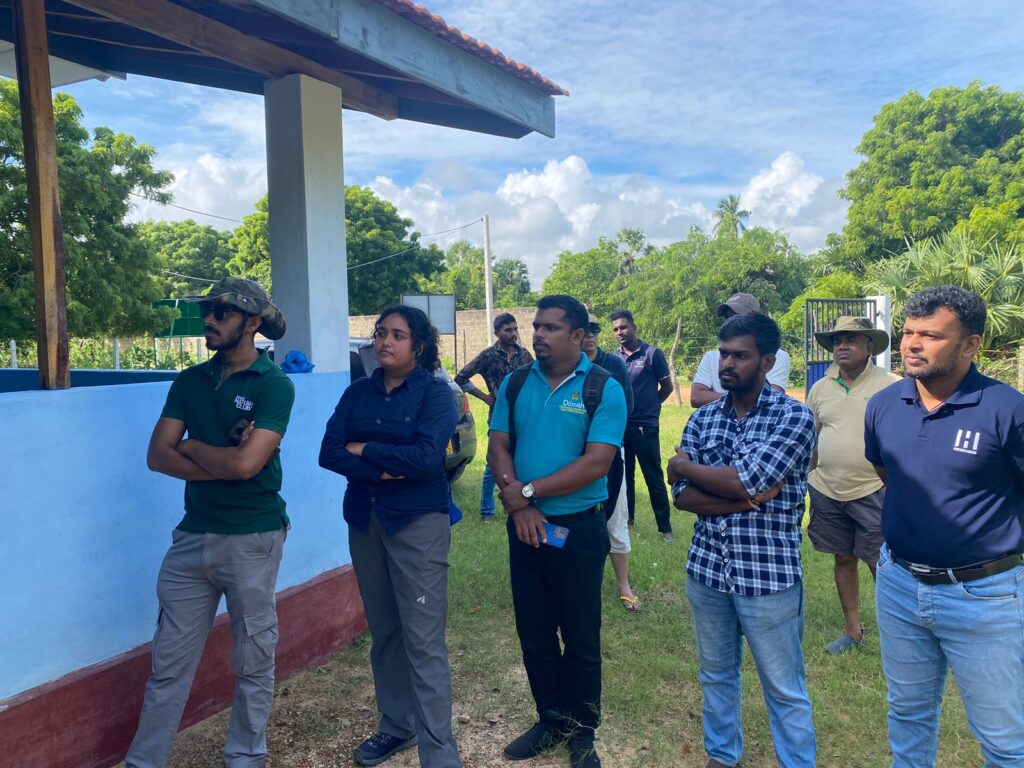
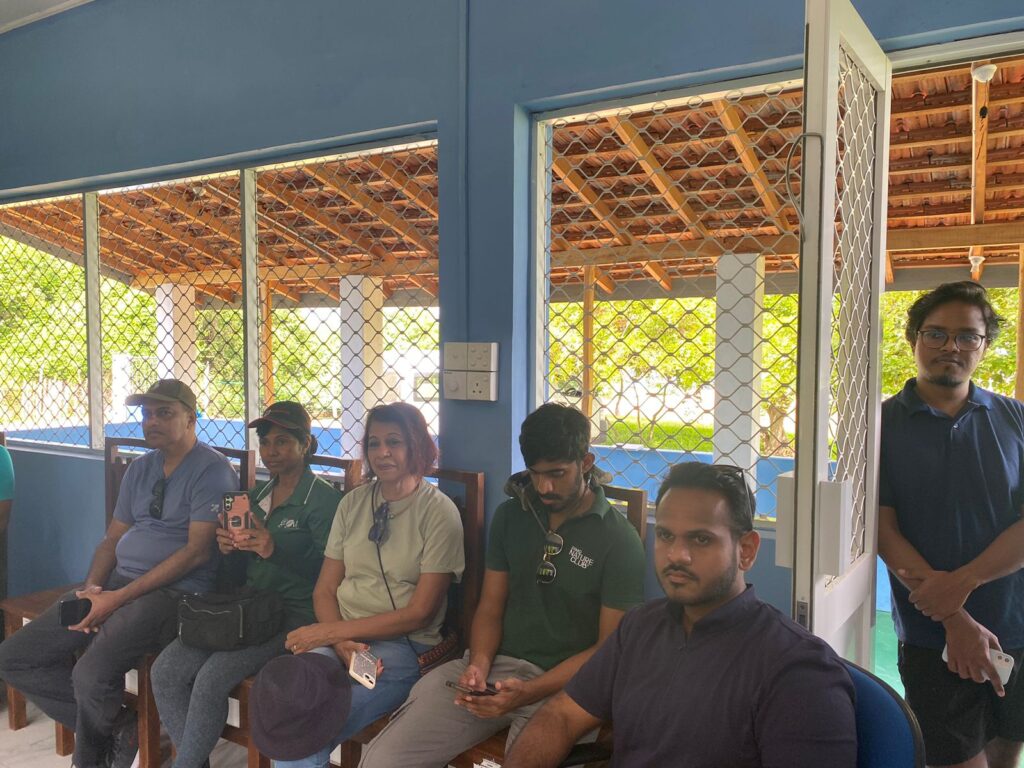
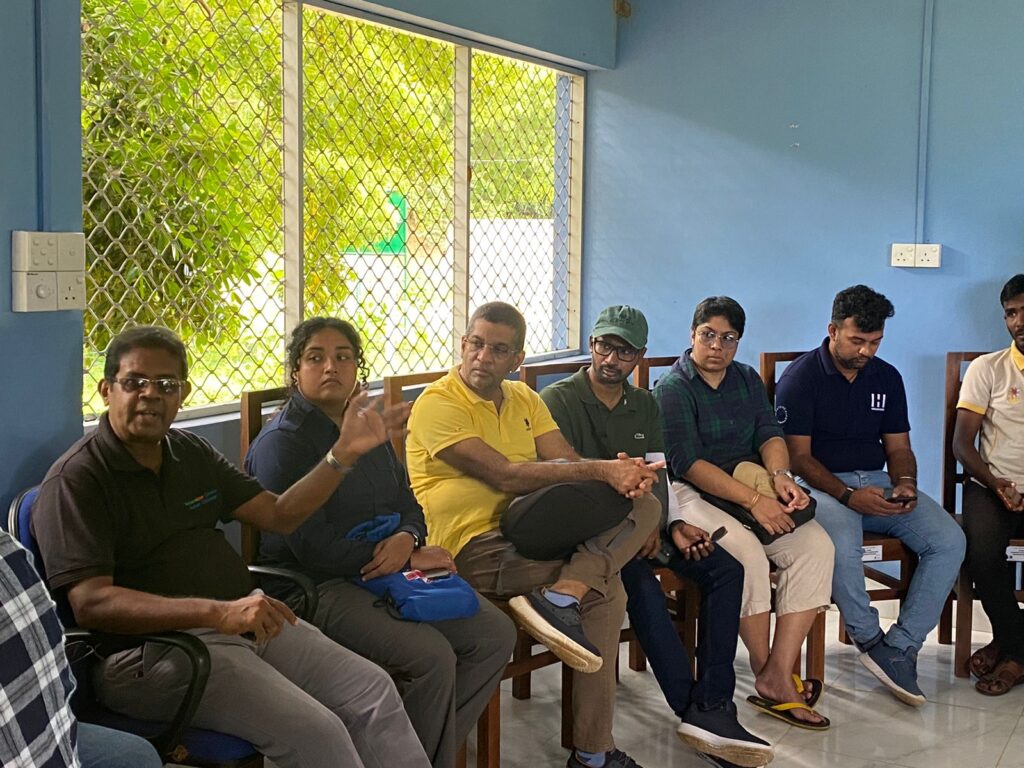
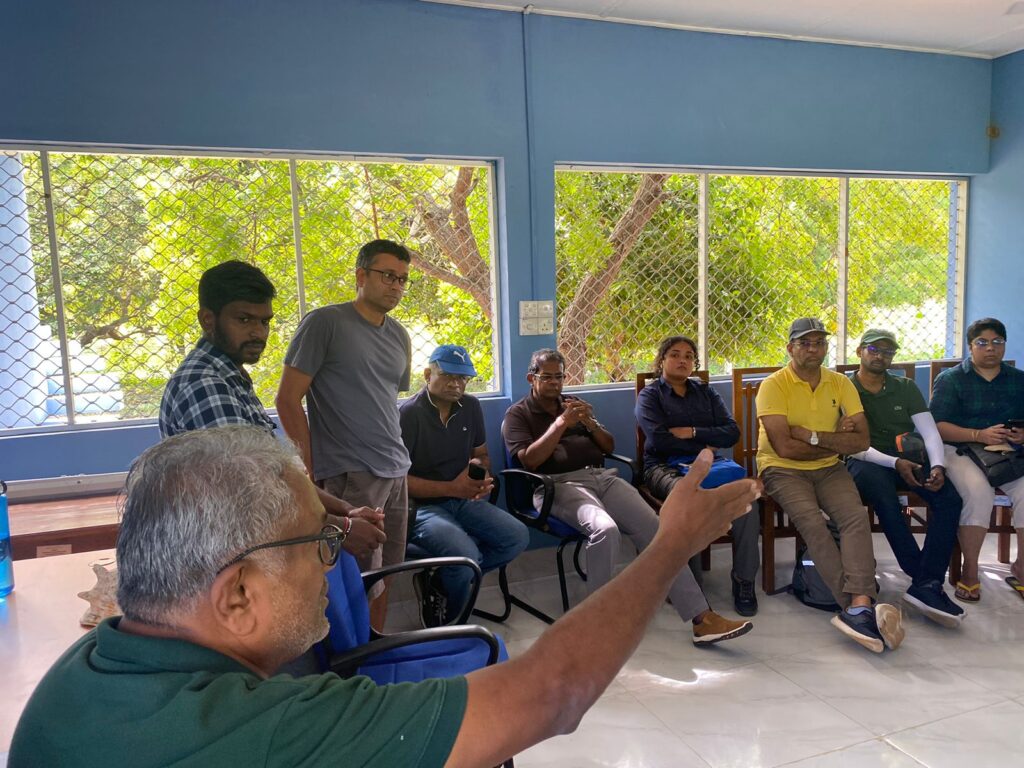
Day 1: Journey to Kayankerni
The field visit commenced on 5th December, with participants gathering at the Ceylon Chamber of Commerce in Colombo before departing for Kayankerni. A stop in Dambulla provided an opportunity for informal networking over dinner, setting the stage for deeper discussions on conservation and business engagement. The group arrived at Malu Malu Resort & Spa, Pasikudah, late in the evening.
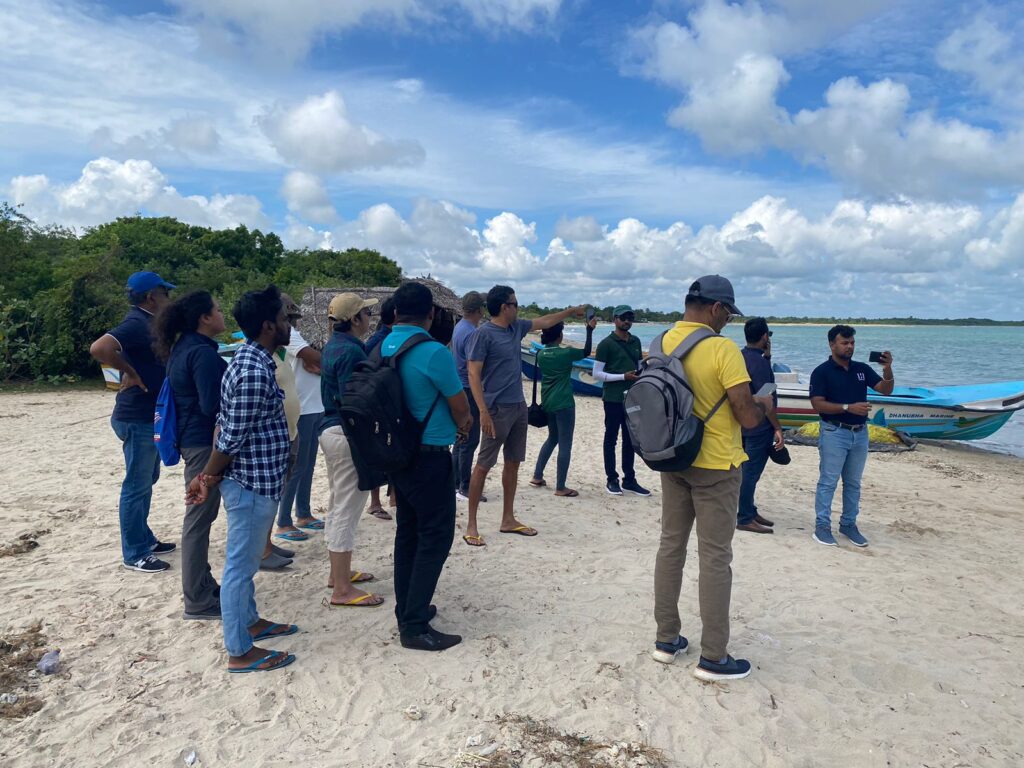
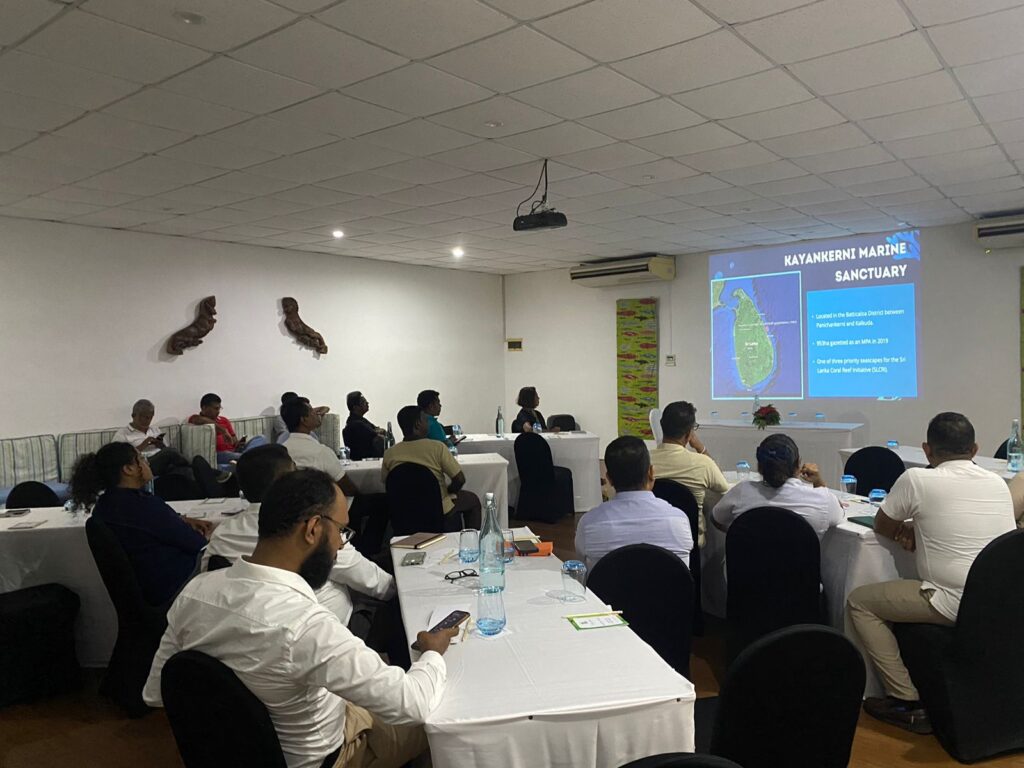
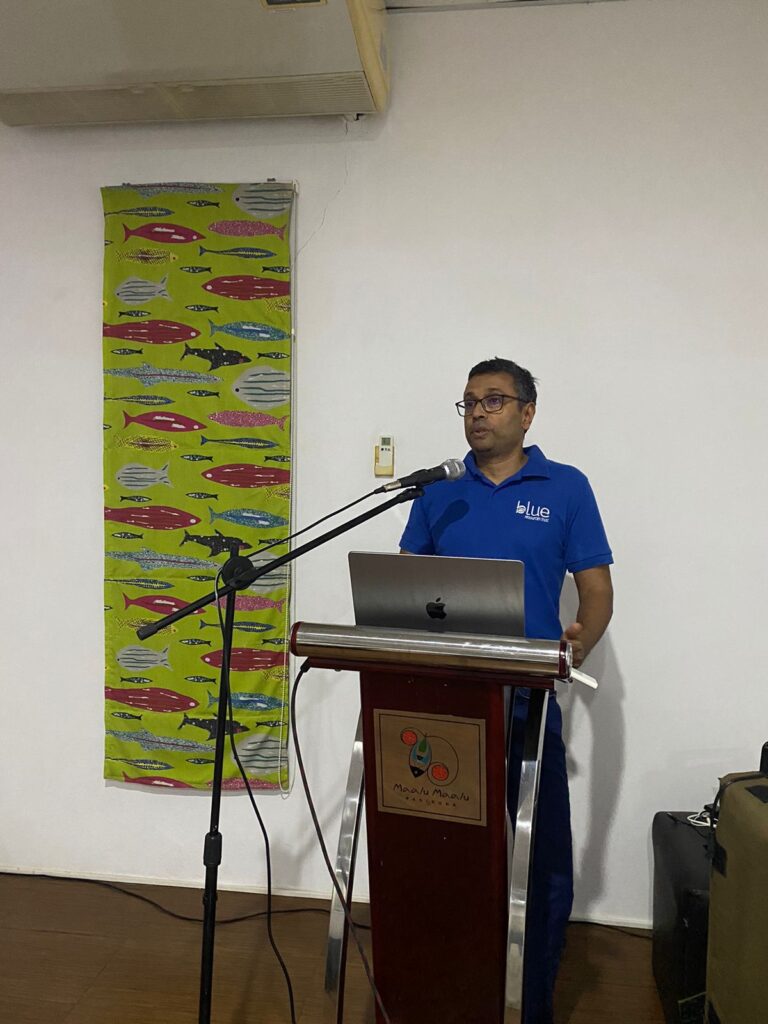

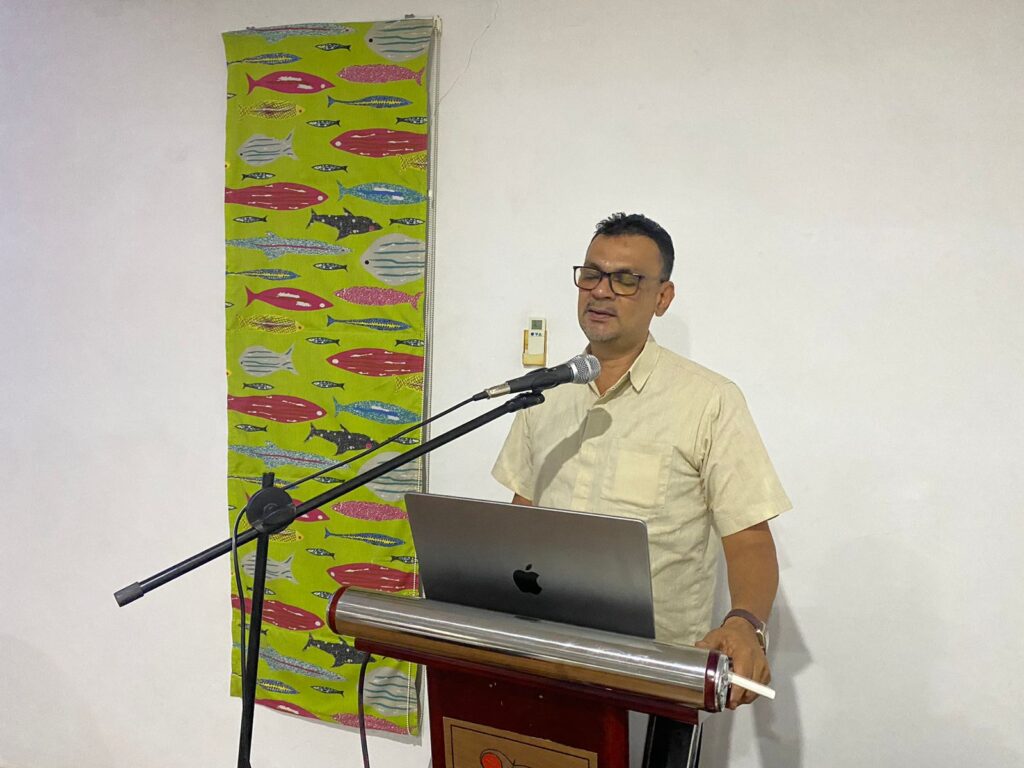
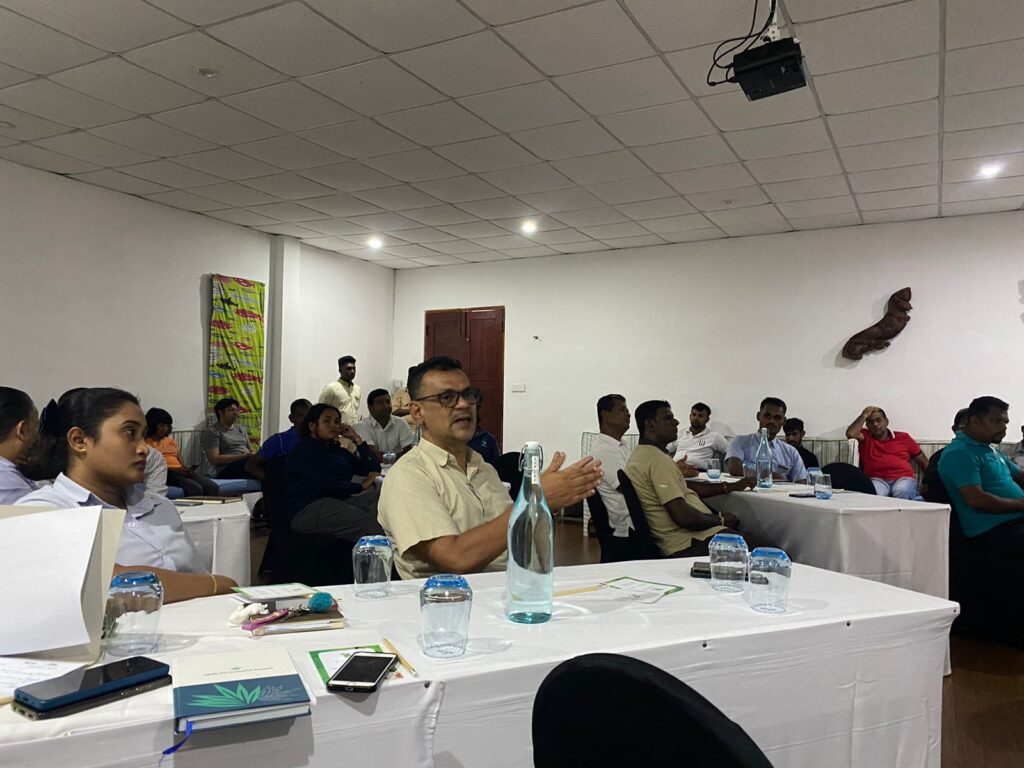
Day 2: Exploring the Reef and Engaging with Local Communities
On 6th December, the team departed for Kayankerni early in the morning for an interactive field awareness session. Conducted by Blue Resources Trust (BRT), the project’s implementation partner, this session highlighted:
✅ The ecological importance of the Kayankerni Reef.
✅ The role of coral conservation in protecting biodiversity.
✅ How the project aligns with local socio-economic development.
Following the awareness session, a focused group discussion took place between the corporate participants and members of the Kayankerni Fishery Association. The discussion explored sustainable livelihood options that would allow local communities to reduce their dependence on fishing practices that harm the reef.
🌱 Key Takeaway: The community expressed strong interest in shifting to biodiversity-friendly livelihoods, but lack of market demand has hindered previous efforts. The project aims to bridge this gap by promoting eco-tourism and sustainable business models.
Experiencing Nature-Based Solutions Firsthand
Kayak Tour through Mangroves
To provide a hands-on experience, participants embarked on a guided kayak ride through the mangrove ecosystems of Kayankerni. This immersive activity showcased the biodiversity of the seascape and highlighted the potential for developing a formal kayak trail as a sustainable tourism initiative. The kayak ride served as a preliminary trial, with participants providing valuable feedback on how this initiative could be improved to attract eco-tourists.
Community-Hosted Lunch
A traditional meal prepared by the local community gave visitors a taste of Kayankerni’s culinary heritage. This experience further underscored how local food tourism could be integrated into eco-tourism models to generate alternative income sources for the community.
Engaging with the Hospitality Sector
Following the site visit, the team returned to Pasikudah for a strategic meeting with the Pasikudah Hoteliers’ Association. This discussion focused on how sustainable tourism could be leveraged to support coral conservation and community development.
Key Insights from the Hoteliers:
✔️ Hotels are open to promoting eco-tourism in Kayankerni.
✔️ A structured tourism strategy with clear branding and safety measures is essential to attract visitors.
✔️ There is strong potential for collaboration between local businesses, hotels, and conservation partners.
By integrating sustainable tourism practices, the hospitality sector can become a key player in reef conservation, ensuring long-term economic and environmental benefits.
Observations and Key Takeaways
🔹 Corporate Engagement is Growing – The visit reinforced the role of private sector partnerships in conservation, with four companies already signed up as project partners and more expressing interest.
🔹 Alternative Livelihoods Need Market Support – While eco-tourism and sustainable fisheries hold promise, demand generation and branding will be crucial for success.
🔹 Tourism Can Be a Game-Changer – A well-structured eco-tourism strategy could provide long-term financial sustainability to conservation efforts and local businesses.
🔹 Collaboration is Essential – Stronger engagement between businesses, conservationists, government agencies, and local communities will be needed to ensure project success.
Strengthening Partnerships & Moving Forward
The Life to Our Coral Reefs project is a long-term initiative that will require sustained corporate engagement, local participation, and conservation expertise. Based on the insights gained during the site visit, BSL and its partners will focus on:
📌 Formalizing corporate partnerships to secure financial and technical support.
📌 Developing a sustainable eco-tourism model, including the kayak trail and local food experiences.
📌 Strengthening engagement with the Pasikudah hospitality sector to integrate reef conservation into their operations.
📌 Providing skills training and market linkages to ensure sustainable livelihoods for coastal communities.
Join Us in Protecting Sri Lanka’s Reefs!
BSL invites businesses, conservation organizations, and individuals to become a part of this impactful initiative. By working together, we can restore our reefs, support communities, and promote sustainable business practices that benefit both people and nature.
#BSL #LifeToOurCoralReefs #Kayankerni #CoralConservation #SustainableTourism #EcoTourism #ProtectOurOceans
#Dilmah #CDB #CommercialBank #SpaCeylon #CinnamonHotels #Hirdaramani #DIMO #NDB #BlueResourcesTrust
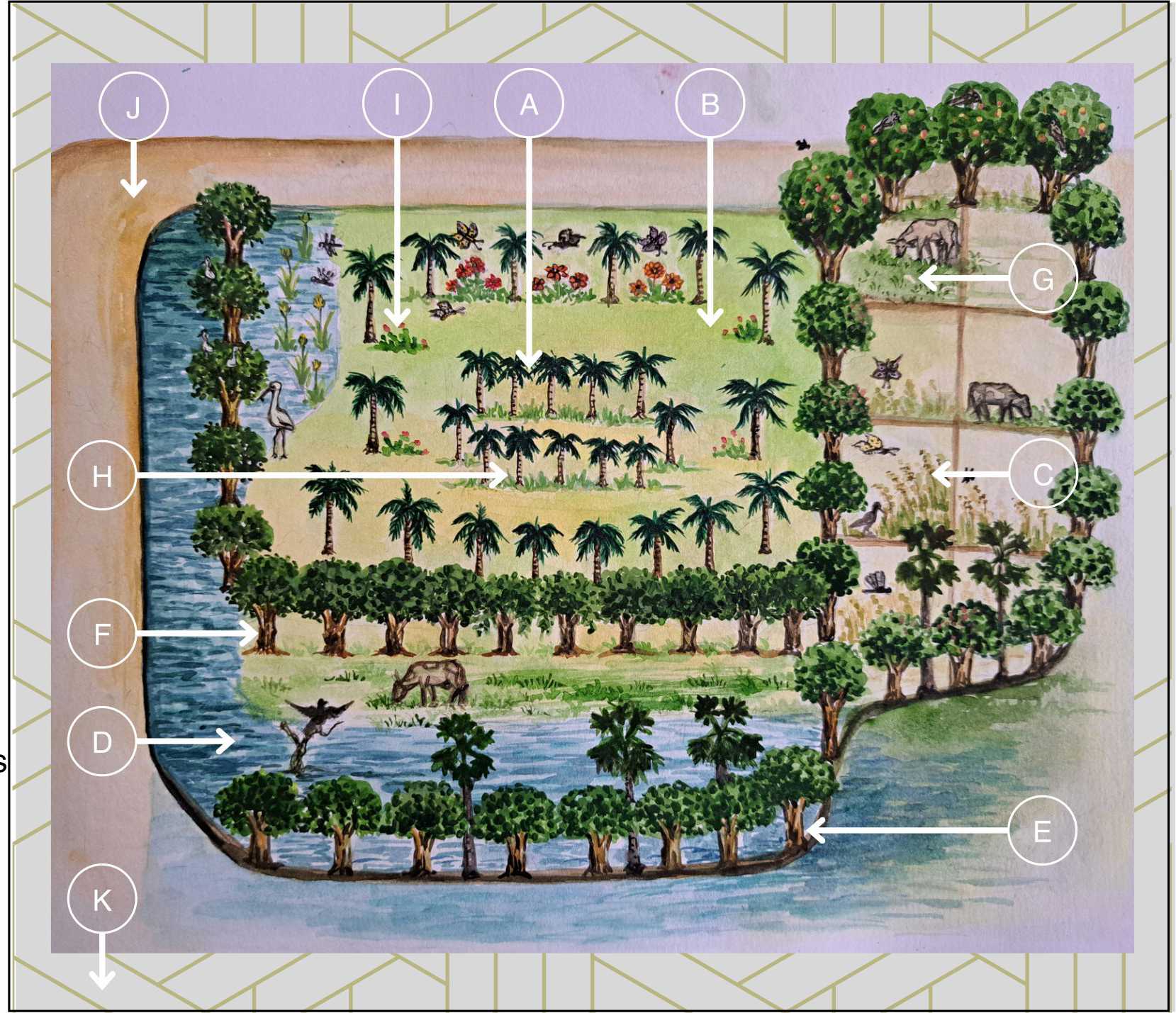
Mannankulam Estate: Embracing Heritage and Sustainability with Biodiversity Sri Lanka
We are delighted to announce that Mannankulam Estate has joined Biodiversity Sri Lanka (BSL) as a General Member. Nestled in the heart of Sri Lanka’s East Coast, Mannankulam Estate is a beacon of cultural preservation, sustainable agriculture, and environmental stewardship. Their partnership with BSL underscores a shared commitment to conserving Sri Lanka’s rich biodiversity and promoting sustainable development.

A Legacy Rooted in the East Coast
Mannankulam Estate, located in Akkaraipattu, is more than just a destination; it’s a journey into the soul of Sri Lanka’s East Coast. Spanning 25 acres, the estate has been in the hands of the same family for four generations, serving as a testament to their dedication to preserving the region’s heritage. The estate offers visitors an immersive experience through thoughtfully curated itineraries that celebrate the area’s culture, history, nature, art, and architecture. Guests are invited to stay in one of four personal homes, each reflecting unique Sri Lankan architectural styles, from early 19th-century colonial designs to contemporary tropical architecture by Anjalendran, a renowned architect who collaborated with Geoffrey Bawa in the 1980s.
Commitment to Sustainable Agriculture
At the heart of Mannankulam Estate lies a profound respect for nature and a commitment to sustainable practices. The estate is a certified organic farm under SLS 1324 standards, cultivating a diverse range of produce, including coconuts, vegetables, fruits, and a sustainable amount of livestock. By prioritizing heirloom varieties and traditional production methods, Mannankulam Organics ensures that their products reflect the culture and values of the land. This approach not only preserves the integrity of the environment but also promotes health and well-being for consumers.

Biodiversity Conservation Efforts
Mannankulam Estate is a sanctuary for a remarkable array of flora and fauna. The property boasts rich biodiversity, hosting 218 plant species, 58 bird species, 28 butterfly species, 11 fish species, 12 mammal species, and 10 reptile species. The estate’s commitment to environmental conservation is evident in its efforts to enhance this biodiversity, creating habitats that support various indigenous species. Guests can engage in walking and bike tours, offering opportunities to observe and appreciate the estate’s natural beauty firsthand.
Cultural and Artistic Enrichment
Beyond its natural allure, Mannankulam Estate is a cultural haven. The estate houses a private collection of Sri Lankan contemporary and ancient art, including sculptures, paintings, and photographs from esteemed local artists. This artistic curation offers guests a deep dive into the island’s rich artistic heritage. Culinary experiences at the estate are equally enriching, featuring authentic Batticaloa cuisine crafted from traditional family recipes, allowing guests to savor the true flavors of the East Coast.
A Harmonious Partnership with BSL
The alliance between Mannankulam Estate and Biodiversity Sri Lanka is a natural convergence of shared values and objectives. Both organizations are dedicated to the preservation of Sri Lanka’s unique biodiversity and the promotion of sustainable practices that benefit both the environment and local communities. Through this partnership, they aim to foster initiatives that support environmental conservation, cultural preservation, and sustainable tourism, ensuring that the natural and cultural heritage of Sri Lanka’s East Coast is cherished and protected for generations to come.
For more information about Mannankulam Estate and their initiatives, please visit their official website: https://mannankulam.com

Ayurveda and Conservation Unite: Barberyn Ayurveda Resorts Becomes a BSL Member

We are thrilled to announce that Barberyn Ayurveda Resorts has joined Biodiversity Sri Lanka (BSL) as a new General Member. Nestled in the tranquil coastal town of Beruwala, Western Province, Sri Lanka, Barberyn Reef Ayurveda Resort Hospital is a sanctuary of holistic well-being and sustainable living. With a rich history spanning over 55 years, this pioneering Ayurvedic resort has seamlessly blended traditional healing practices with modern hospitality, creating a haven for those seeking rejuvenation and inner peace. Their membership in BSL is a testament to their unwavering commitment to environmental stewardship and sustainable development.
A Legacy of Holistic Healing and Sustainability
Founded in 1968 by visionaries Mr. Sudana Rodrigo and Mrs. Chitra Rodrigo, Barberyn Reef Ayurveda Resort Hospital has been at the forefront of Ayurvedic tourism in Sri Lanka. Their profound vision of sustainability, encompassing the sanctity of life, human consciousness, and inner peace, has guided the resort’s operations and growth. Today, under the leadership of their son, Manick Rodrigo, the resort continues to uphold these values, emphasizing human development that rests on the sustainability of life, both physical and spiritual.
Authentic Ayurvedic Healing
At the heart of Barberyn Reef Ayurveda Resort Hospital is its dedication to authentic Ayurvedic healing. The resort offers personalized treatment programs designed by experienced Ayurvedic doctors, including detoxification, rejuvenation, and stress relief therapies. Daily meditation and yoga sessions further enhance mental and physical well-being, while Ayurvedic cuisine, prepared according to Ayurvedic principles, focuses on nutrition and balance. Comprehensive wellness programs cater to various health needs, including weight management, skin care, and chronic illness management.

A Commitment to Sustainability
Barberyn Ayurveda Resort’s commitment to sustainability is evident in every aspect of its operations. The resort’s sustainability initiatives align seamlessly with the goals of Biodiversity Sri Lanka, making BSL membership a natural and harmonious partnership.
Reduce, Reuse, Recycle
The resort has implemented a robust waste management system, categorizing waste as degradable and non-degradable. Non-degradable waste is further sorted into plastic, iron, and glass, with plastic cans repurposed to grow plants in the nursery. Organic waste is recycled into compost and biogas, while non-degradable waste is sold for recycling. These efforts not only reduce waste but also promote a circular economy, aligning with BSL’s mission to promote sustainable resource management.
Go Green to Breathe Clean
With 80% of the land covered in greenery, predominantly herbal plants, Barberyn Reef Ayurveda Resort Hospital is a verdant oasis. The resort maintains a herbal plant nursery to supply medicinal plants for Ayurvedic treatments and propagation. This green coverage not only enhances the resort’s aesthetic appeal but also contributes to biodiversity conservation, a core focus of BSL.
Live Under Eco-Friendly Shelters
The resort’s buildings are designed with sustainability in mind, featuring natural ventilation to reduce the need for air conditioning and minimizing the use of plastics in construction. Most furniture is made from wood, further reducing the resort’s environmental footprint. These eco-friendly practices align with BSL’s goal of promoting sustainable building and construction practices.

Sustainability Through Renewable Energy
Barberyn Reef Ayurveda Resort Hospital has embraced renewable energy by installing solar panels for electricity generation. With a goal to meet the entire energy requirement through solar power by 2025, the resort is making significant strides towards reducing its carbon footprint. This commitment to renewable energy aligns with BSL’s mission to promote clean and sustainable energy solutions.
Path to Vegetarian – Take Extinction Off Your Plate
The resort has made efforts to minimize meat consumption due to its environmental impact, promoting a predominantly vegetarian diet. Innovative cooking methods are used to reduce edible food waste, further contributing to sustainability. These initiatives resonate with BSL’s focus on sustainable food systems and reducing the environmental impact of food production.
Sustainable Procurement
Barberyn Reef Ayurveda Resort Hospital sources eco-friendly products and materials, supporting local suppliers and producers to reduce the carbon footprint of hotel operations. This commitment to sustainable procurement aligns with BSL’s goal of promoting environmentally responsible business practices.
Clean Ocean for Healthy Joy
The resort conducts daily beach clean-up sessions to keep the shore free from plastics, contributing to marine conservation. This initiative aligns with BSL’s focus on protecting marine ecosystems and promoting clean oceans.
Environmental Education
Barberyn Reef Ayurveda Resort Hospital provides training and awareness programs for staff, guests, and the local community. Webinars, workshops, and seminars on sustainable tourism and the usage of indigenous medicine further promote environmental education. These efforts align with BSL’s mission to raise awareness and educate stakeholders on biodiversity conservation.
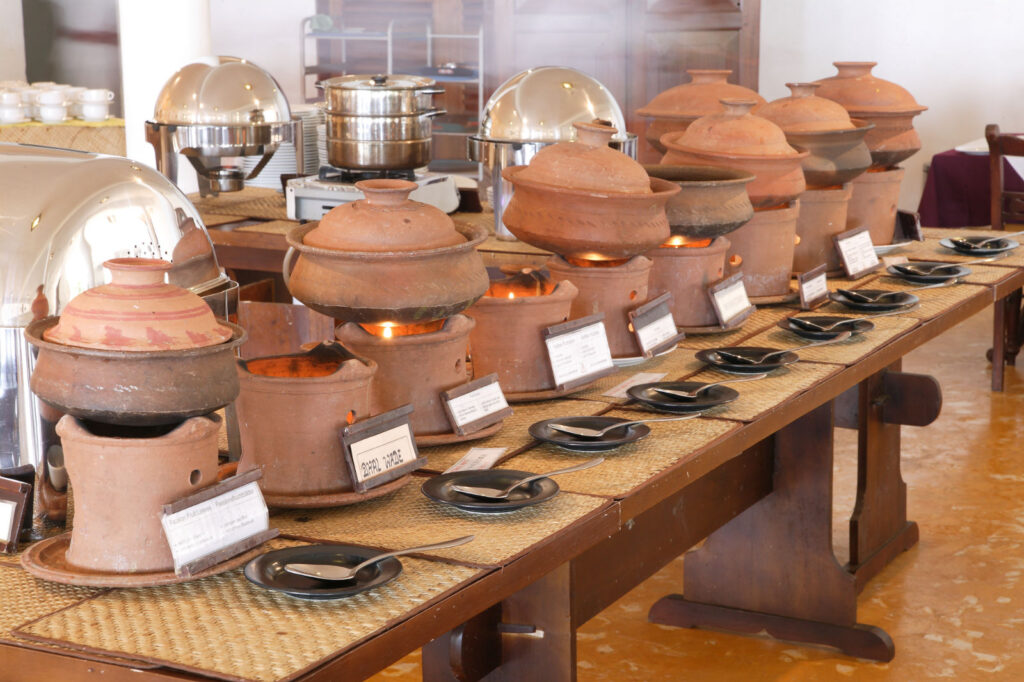
Environmental Conservation Projects
The resort is actively involved in mangrove conservation in the Didduwa area, tree planting initiatives, and maintaining medicinal plantations over 50 acres. These projects promote reforestation, combat climate change, and enhance biodiversity, aligning with BSL’s focus on habitat restoration and conservation.
Science for Every Single Bit of Nature
Barberyn Reef Ayurveda Resort Hospital has constructed wastewater treatment and biogas production plants using scientific approaches. Water used for consumption is tested every three months to ensure safety. These initiatives align with BSL’s mission to promote scientific research and innovation in environmental conservation.
Awards and Recognition
- Presidential Environmental Award 2024 – (Silver Award in Hotel Sector)
- Presidential Environmental Award 2023 – (Merit Award in Hotel sector)
- Presidential Environmental Award 2022 – (Merit Award in Hotel sector)

A Vision for the Future
As Barberyn Ayurveda Resorts joins Biodiversity Sri Lanka, it is a testament to their shared vision of a sustainable future. The resort’s holistic approach to well-being, combined with their commitment to environmental stewardship, makes them a valuable partner in BSL’s mission to conserve biodiversity and promote sustainable development.
Barberyn Ayurveda Resort’s membership in Biodiversity Sri Lanka is a natural alignment of values and goals. Their dedication to authentic Ayurvedic healing, sustainable practices, and environmental conservation makes them a beacon of sustainable wellness. As they continue to lead by example, Barberyn Ayurveda Resorts and Biodiversity Sri Lanka will work together to create a healthier, more sustainable future for all.
For further information, please visit the Barberyn Ayurveda Resort’s website: https://www.barberynresorts.com



